9b3231a3f2ecb4896d8dfba841947581.ppt
- Количество слайдов: 158

Tri. Met High Impact Business Writing CLIMB Center for Advancement Portland Community College Facilitated by George Knox

Overview of Workshop Modules n Pre-Writing Analysis n Organization & Formatting n Strategies for Specific Documents n Style & Diction n Grammar, Punctuation, Spelling n Proofreading, Revising & Editing

Perception Studies show that we all have preferred “perceptual styles” n Presenter’s preferences may be different than audience’s n Effective perception combines styles n

Perceptual Styles (Adapted from Dunn and Dunn Learning Styles Model) Auditory Visual Focuses on what is seen heard Remembers 75% seen Remembers 75% heard Summarizes with notes Distracted by note-taking Tactile Kinesthetic Focuses on what is touched and manipulated Remembers by touching Takes both traditional and visual notes Focuses on moving within contextual environment Remembers by doing Distracted by note-taking

Perceptual Styles (Cont. ) n n n Perceptual styles are only preferences Most people utilize more than one style Most people can learn to use different styles SO Recognize your preference, but learn to use the style(s) that work best for each situation n Prepare your documents with audience’s perceptual styles (multiple) in mind n

Document Development n P. A. T. – Purpose – Audience – Technique n Purpose and Audience Determine Technique!

P. A. T. n Purpose – Topic – Goals (Inform, persuade, entertain, record, cite, respond, etc. ) – Requirements (Schedule, materials, budget, tools, delivery, etc. ) n Audience – Who? Multiple audiences? – Expectations (Content, style, delivery, etc. ) – Requirements n Technique

Pre-Writing Techniques n Brainstorming • Write down any ideas that come to you • Write fast • Write until you have nothing else to write

Pre-Writing Techniques n Freewriting • Time yourself • Start writing on the topic and don’t stop until the time is up • Don’t worry about sentence structure, spelling, grammar

Pre-Writing Techniques n Cluster Map • Brainstorm based on cluster structure • Clump key ideas around who, what, when, where, why and how bubbles • Write until you have nothing else to write

Overcoming Writer’s Block n P. A. T. n Write out main message/point n Sentence Outline n Diagram/Flow Chart n Don’t write sequentially n “Talk it out” n Take a break and come back later

Document Design: Focus “The Rule of Ones” – One idea per sentence – One topic sentence per paragraph – One thesis/main point per document

Document Design: Format Informative n Intro of problem n Main point n Details n Summary (restating main point) Persuasive n Intro of problem n Main point n Supports n Summary n Request for action Instructional n Intro of problem n Steps in sequential order n Sources of further help

Document Design: Flow Front load vs. back load n Roadmap n – Statement of purpose – Overview of content n Signposts (Text) – Transitional phrases and words n Cues (Visual) – Visual elements guiding reader – Headings, highlighted text, dividers, white space Chunking (Grouping related elements) n Parallel form n

Document Design: Graphics n Integrate graphics into text – See Tips for Using Visuals n Maintain a graphic theme n Generally do not use clip art or extraneous graphics formal documents n Follow corporate/publication guidelines n Adhere to copyright law

Document Design: Other Issues n Headings, spacing, pagination, type n Titles, length, submission n Documentation of sources All of these are dependent upon the publisher and style guide

Formatting Text n n n n 10 -12 point type (body text) Serif vs. San Serif Consistent type styles (“Magic 3”) Bold/italics to emphasize Avoid all capitals Ragged right – justified left margins Text boxes, large size, color for emphasis Formatting Your Document (Tri. NET) http: //trinet/mktg-custsvc/mktg/creative_services/formatting. htm

Memo and E-mail n Purpose – Written record (paper or electronic) – Information re: policies and procedures – Request for internal action – Documentation of decisions or actions – “Paper trail”

Memo and E-mail n Audience – Internal (usually) – Individual, departmental or company-wide – Knowledge of company organization, values, policies, procedures, etc. – Familiar with jargon and acronyms – Attention to internal communications? Note: E-mail is becoming more common for external communications

Technique: Memos & E-mail n Procedure n Request and Information Messages and Reply Messages n Confirmation n Other? (or Denial) Messages

Procedure/Information Message n Routine messages n “Downward” flow n Informational in nature Goal of employee participation and cooperation n Direct or indirect depending on nature of message (good news, bad news, etc. ) n Tip: Tone is important for success.

Request and Reply Messages n Request for information and action – Persuasive in nature – Direct or indirect depending on nature of request and source of request n Reply to previous communication – Direct response to initiator – Indirect response to wider audience

Confirmation Messages n “Incident” or “To File” reports n Documentation of decisions, directives, and discussions n Names and titles of people involved n Major issues described n Request for confirmation of receipt n Direct message

Technique: Strategies n Headings: n Single Date, To, From, Subject topic n Conciseness n Conversational n “Cues” tone and “Signposts”

Technique: Strategies n Direct vs. Indirect message – Direct (“Front loaded”) message places main point early in the document – Indirect (“Back loaded”) message places main point late in the document – Use direct approach for “good” news or when acceptance is assured – Use indirect approach for “bad” news or when persuasion is necessary

Techniques: Delivery n Memos – Use standard in-house delivery unless otherwise requested n E-mail – Use in-house standards (company vs. personal web-based e-mail, stationary, HTML vs. text only, etc. ) within company – Contact outside audiences for restrictions n Avoid common e-mail mistakes

Common E-mail Mistakes n n n Address errors Long messages or attachments Misleading or vague subject lines Inappropriate content Lack of discretion in responses Inappropriate copying and forwarding Source: John Edwards, “The Six Most Common Mistakes in Sending E-mail”, Bottom Line Business, October 1997.

Letters n Purpose – Written record (Paper) – Formal information, persuasive or responsive communication – Documentation with “wet” signature – “Official” communication with letterhead – Contractual agreement – “Paper trail”

Letters n Audience – External (usually) – May be unfamiliar with internal organization, values, procedures, etc. – May be unfamiliar with jargon and acronyms – May be inattentive to communication – Seeking formal or “official” message

Technique: Kinds of Letters Routine Letters – Request for information and action – Direct reply n Good News – Approved request – Commendation/Recommendation n Bad News Letters – Denied request – Criticism/disciplinary action/termination n Persuasive Letters – Sales -Proposals n

Technique: Strategies n Single topic n Formal style and tone n “Official” n “Cues” letterhead and signature and “Signposts” n Request for action

Technique: Strategies n Direct vs. Indirect message – “Front load” Routine and Good News Letters – “Back load” Bad News Letters – For Persuasive Letters, use the message that best fits the audience Tip: If cost is involved, you probably should “back load”.

Communicating Bad News n Goals – Make the audience understand accept – Maintain positive image of organization – Make message clear so additional communication is unnecessary – Avoid creating legal liability

Communicating Bad News n Strategies – Indirect message • Buffer with a neutral or positive opening • Give reasons or causes for bad news • Clearly state bad news, providing alternatives or “next steps” if possible • Close with a personal, future-looking statement Tip: Use subordinating or passive language (“Although your claim cannot be processed under current guidelines, we can provide a list of alternative …. ”)

Communicating Bad News n Strategies – Avoiding Liability • Do not use abusive language (defamation) or careless language implying liability • Do not state or imply views that run contrary to your organization • Do not admit or imply responsibility without checking with legal counsel • Do not use “official” documents or equipment to communicate your personal views

Persuasive Writing Strategies: Gain attention – Review problem and state action taken – Stimulate a question and offer an answer – State a benefit to the audience n Build interest – Offer strong supports – Suggest direct and indirect benefits – Avoid emotionality n

Persuasive Writing Strategies: Reduce resistance – Counter possible arguments – Demonstrate credibility n Motivate action – Request specific action and repeat benefits n Reinforce business relationship n

Technical Formats n Instructions n Reports n Executive Summaries

Instructions n Purpose – Technical documentation of a specific task – Directive with sequential steps – “Used” during task n Audience – Varying technical abilities – “Users”, not readers – May need hazard statements

Technique: Document Types n n n n User Manual (Step-by-step for novice) Tutorial (Mini-lessons for novice) Reference Manual (Indexed for expert) Quick Reference Guide (Indexed for expert) Procedural Guide (Step-by-step for novice & expert, Primarily to document) Policy Manual (Categorized for novice & expert, Primarily to document) On-Line Documentation (Tree structures/topics for novice & expert)

Technique: Basic Format Introduction 2. Required materials/tools 3. Sequential steps 4. Additional resources 1.

Technique: Strategies n Keep language simple and direct – 2 nd person imperative – Appropriate technical language – Active voice – Avoid future tense – Industry standards (e. g. ANSI)

Technique: Strategies n List steps sequentially – Numbered lists for ordered tasks – Bulleted lists for unordered tasks – Vertical lists usually easier to read than horizontal lists – Introduce steps or groups of steps (e. g. “To install the software, follow these steps: ”)

Technique: Strategies n Emphasize tasks over results (user’s actions before reactions) n Describe any necessary parts, tools or equipment BEFORE giving directions n Include visuals when appropriate (especially for “visual perceivers” and international readers)

Technique: Hazard Statements n Place warnings before and near the hazardous task listed n Highlight warning w/ appropriate visual techniques (symbols, colors, bold, etc. ) n Keep hazard statements direct, clear and accurate n Follow expected/required guidelines

Reports n Purpose – Document primary or secondary research – Aid decisions, qualify sources and record work or activities n Audience – Expects summaries, methods, findings – May expect recommendations – Data may be scrutinized – Multiple audiences?

Technique: Basic Format Front Matter n – – – Cover Title page Abstract Table of contents List of figures and tables Executive summary

Technique: Basic Format (cont. ) n Introduction – Definition & scope of problem – Background – Methodology – Report organization

Technique: Basic Format (cont. ) n Body – Project details (Data, method review) – Conclusion (Analysis of findings) – Recommendations – Notes

Technique: Basic Format (cont. ) n Back Matter – Appendices – Glossary – Bibliography/References/Works Cited – Resume/Vitae – Index

Technique: Strategies n Primary research – Clear description of methodology – Summary of data gathered (in body) – Access to full data (usually Appended) – Cross references to other research – Secondary sources used in Background to add credibility

Technique: Strategies n Secondary research – Verify your sources with clear documentation – Explain/describe sources as necessary – Use citation style as required or expected

Executive Summary n Purpose – Introduce document – Give synopsis of contents – Persuade reader of validity and importance of document n Audience – Multiple audiences: technical and nontechnical – Expect summary of major points and findings – May be read as “stand alone” document

Technique: Basic Format n Mini-document – Organize around major sections of full document – Condense material into suitable length n “Brochure” – Highlight major sections most relevant to non-technical audience – Categorize and order by importance to audience

Technique: Strategies Length: Usually 1 page, but could be longer (1/16 th rule? ) n Highlight major sections with headings, bulleted lists, graphics, page design (e. g. multi-column), etc. n Language: Use key words and concepts, Explain technical terms and acronyms n Do NOT “cut and paste” or “summarize by list” n

Style: Business vs. Technical Business Writing: n Purposeful n Persuasive n Flexible n Economical n Reader-focused Technical Writing: n Purposeful n Informative n Structured n Economical n Product/processfocused

Style: Business Writing Strategies: n Gain attention early n Clarify benefits to readers n Always include a “request for action” n Front load a positive message n Back load a negative message n n n Use keywords Explain technical or unfamiliar terms Prepare for multiple audiences Avoid conversational and narrative styles Consider multiple modes of delivery

Style: Technical Writing Strategies: n Design document to be “used” rather than “read” n Provide for document navigation n Front load most technical documents n Use appropriate technical & industry terms including acronyms n Use technical graphics whenever possible Create distinct document sections based on use n Provide necessary caution and warning messages n Prepare document for use within technical setting n Consider multiple modes of delivery n

Style: Proper Citation n Use the correct style – (Academic/industry standard, in-house guide, editor/reader preference) n Document your sources in progress – Take notes with source info – Place citations/short-cuts in drafts n Proofread for citations – Citations matched with sources? – Correct style and punctuation?

Diction (Word Choice and Order) Diction affects: n Meaning n Tone n Emphasis

Diction: Barriers to Meaning n Misused words – See Commonly Confused Words n Nonspecific nouns – Area, factor, issue, problem, thing Slang, regional expressions, figures of speech, inappropriate jargon n Euphemisms, pretentious language n – Adult language, collateral damage, disadvantaged, economic downturn, pre-owned, rightsizing n Sexist language

Diction: Barriers to Tone n Inappropriate level of formality – – n Contractions and acronyms Slang, jargon, figures of speech Proper or strict language I’d like to get that info you’ve got posted on your web page. VS. I would like a copy of the information posted on your web site. Improper connotation – Images and emotions associated with a word or phrase – The details he gave were fictional. VS. The details he gave were not factual. VS. The details he gave were incorrect. n Figures of speech, clichés

Diction: Barriers to Emphasis n Multiple terms for same subject – First term has emphasis and sets tone – My client is innocent. I am confident that the jury will find him not guilty due to insufficient evidence. n Active vs. passive voice – Focus on actor or result – The company laid off 300 workers. VS. Three hundred workers were laid off by the company. n Front load vs. back load

Diction: Editing and Revising n Consider PAT n Proof for meaning, tone and emphasis n Default to direct meaning and formal tone (unless writing personal narratives and correspondence) n Generally avoid jargon and slang n Check a dictionary and/or thesaurus
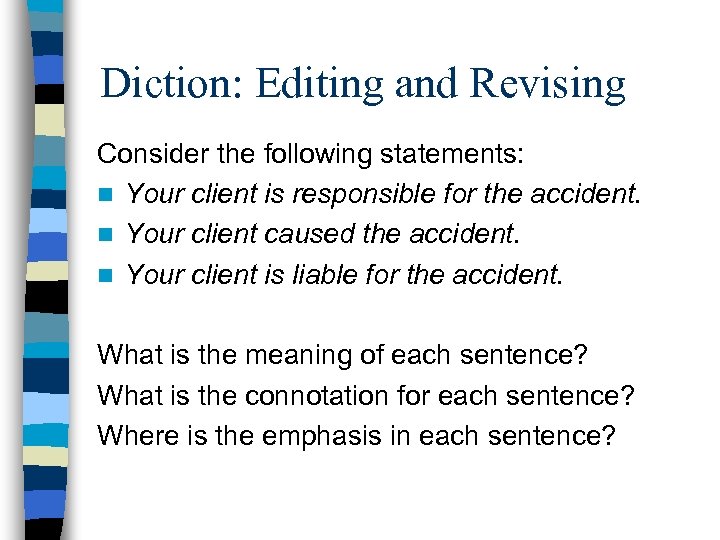
Diction: Editing and Revising Consider the following statements: n Your client is responsible for the accident. n Your client caused the accident. n Your client is liable for the accident. What is the meaning of each sentence? What is the connotation for each sentence? Where is the emphasis in each sentence?

Tri. Met Style Guides n Cliff Notes. TM to Tri. Met Style n Tri. Met Style Guide (Tri. NET) – http: //trinet/mktg-custsvc/mktg/creative_services/style_guide. htm n Simplifying Your Writing (Tri. NET) – http: //trinet/mktg-custsvc/mktg/creative_services/choosing_words. htm n Formatting Your Document (Tri. NET) – http: //trinet/mktg-custsvc/mktg/creative_services/formatting. htm n The “Voice” of Tri. Met

Liability Issues: Risks n “Technical” Liability – Negligence – Breach of Warranty – “Strict Liability in Tort(e)” n Marketing Liability – “Uniform Commercial Code” – Expressed Warranty of Description n Other Areas of Liability – Privacy – Financial – Employment

Liability Issues: Protections n Accuracy – Check for clear interpretations and findings – Do not suppress knowledge or data – Do not exaggerate claims or data n Ownership – Confirm copyright, trademarks, etc. n Public Domain – Most documents by public officials are in public domain (w/ legal/privacy exceptions) – Consider documents as “published”
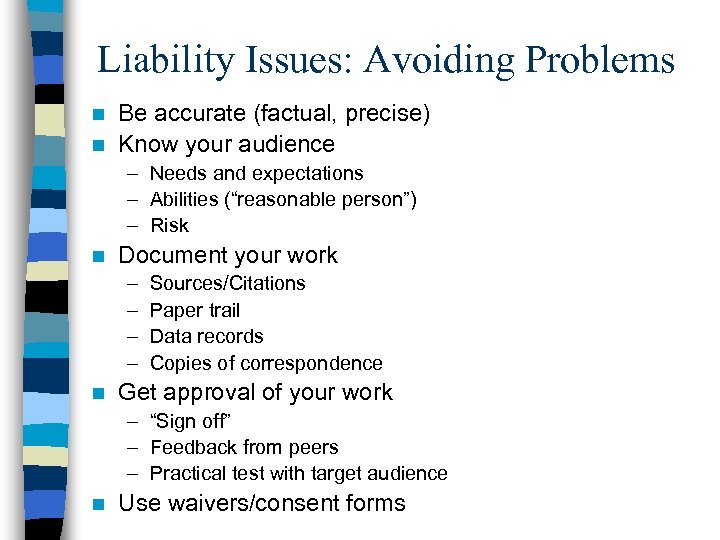
Liability Issues: Avoiding Problems Be accurate (factual, precise) n Know your audience n – Needs and expectations – Abilities (“reasonable person”) – Risk n Document your work – – n Sources/Citations Paper trail Data records Copies of correspondence Get approval of your work – “Sign off” – Feedback from peers – Practical test with target audience n Use waivers/consent forms

Business Grammar “I once shot an elephant in my pajamas. How he got into my pajamas, I’ll never know. ” - Groucho Marx
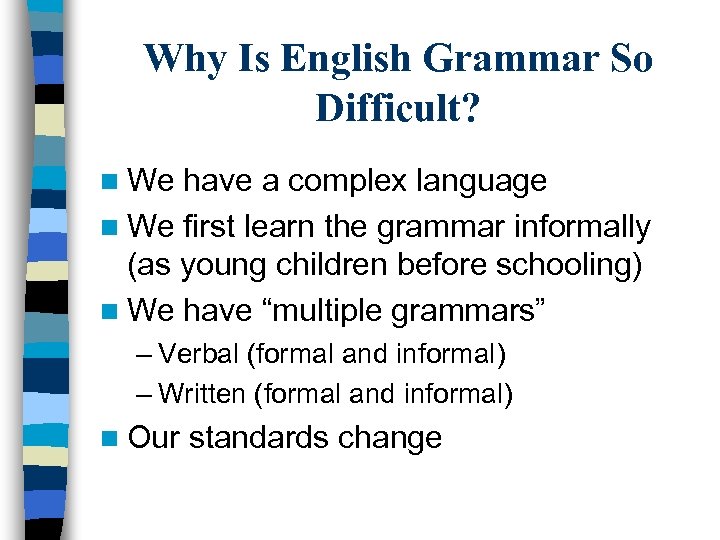
Why Is English Grammar So Difficult? n We have a complex language n We first learn the grammar informally (as young children before schooling) n We have “multiple grammars” – Verbal (formal and informal) – Written (formal and informal) n Our standards change
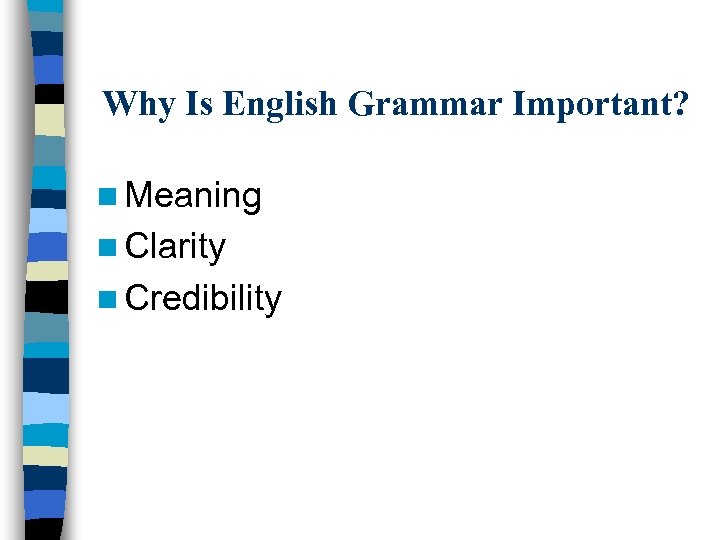
Why Is English Grammar Important? n Meaning n Clarity n Credibility
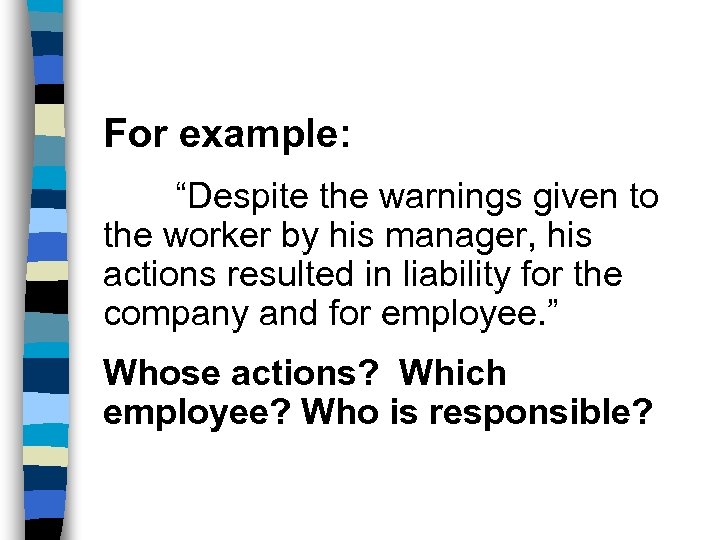
For example: “Despite the warnings given to the worker by his manager, his actions resulted in liability for the company and for employee. ” Whose actions? Which employee? Who is responsible?

The Parts of Speech n n n n n Noun – Names a person, place, thing, idea Verb – Expresses action, being or state of being Pronoun – Substitutes for a noun or group of nouns Adjective – Modifies/describes a noun/pronoun Adverb – Modifies/describes a verb, adjective or another adverb Preposition – Introduces a phrase functioning as an adjective or adverb Conjunction – Joins words or groups of words Interjection – Expresses emotion Article – Points to a noun

Other Important Concepts n Subject – Names who or what the sentence is about, simple or complex n Predicate (Verb) – Expresses the action/being of the sentence n Clause – A group of related words containing a subject and a verb n Phrase - A group of related words without a subject-verb relationship
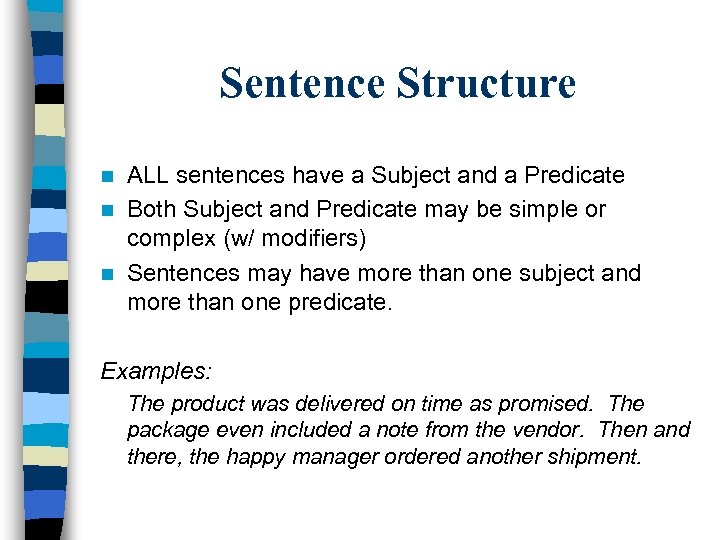
Sentence Structure ALL sentences have a Subject and a Predicate n Both Subject and Predicate may be simple or complex (w/ modifiers) n Sentences may have more than one subject and more than one predicate. n Examples: The product was delivered on time as promised. The package even included a note from the vendor. Then and there, the happy manager ordered another shipment.
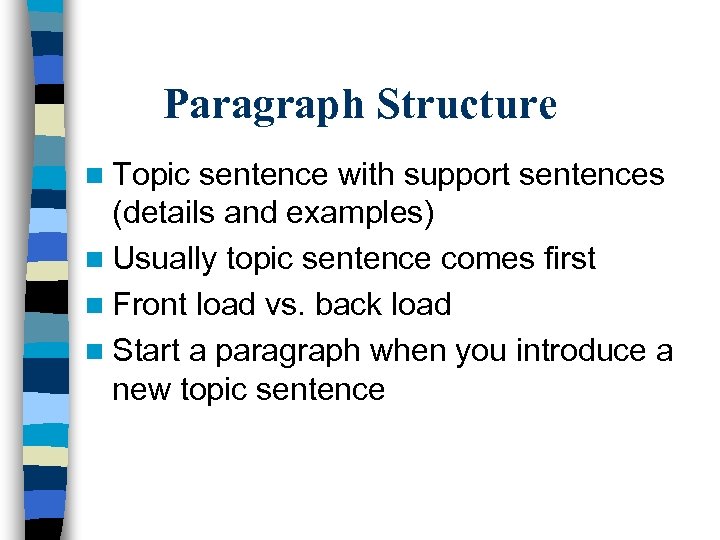
Paragraph Structure n Topic sentence with support sentences (details and examples) n Usually topic sentence comes first n Front load vs. back load n Start a paragraph when you introduce a new topic sentence
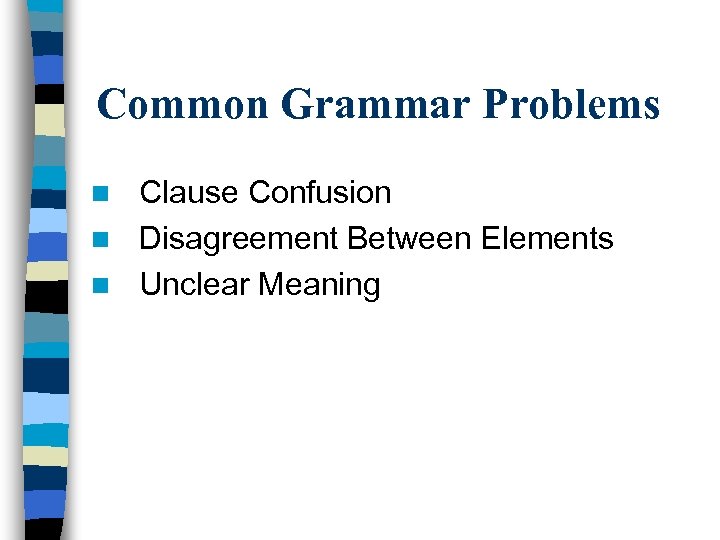
Common Grammar Problems Clause Confusion n Disagreement Between Elements n Unclear Meaning n
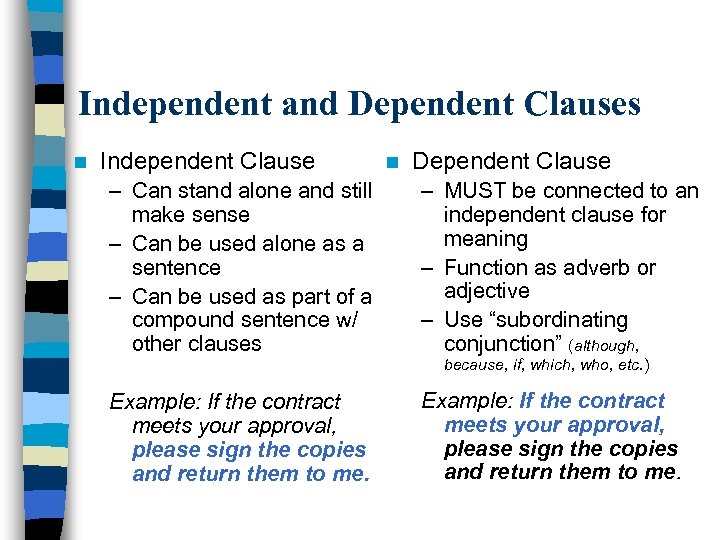
Independent and Dependent Clauses n Independent Clause n Dependent Clause – Can stand alone and still make sense – Can be used alone as a sentence – Can be used as part of a compound sentence w/ other clauses – MUST be connected to an independent clause for meaning – Function as adverb or adjective – Use “subordinating conjunction” (although, Example: If the contract meets your approval, please sign the copies and return them to me. because, if, which, who, etc. )
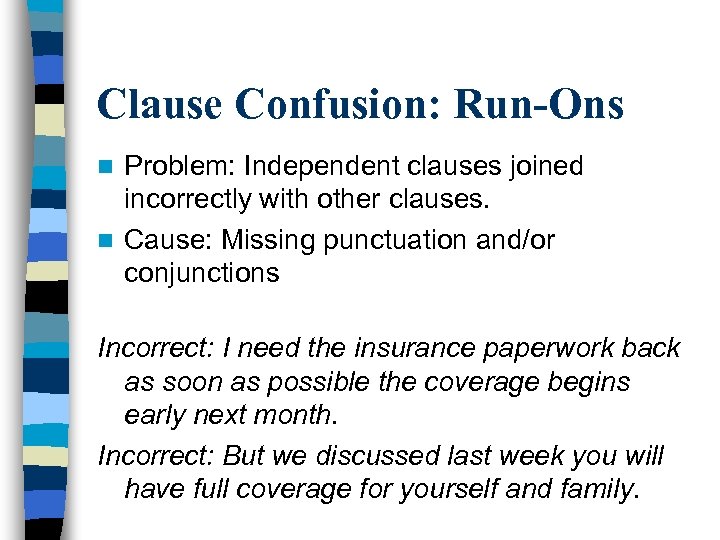
Clause Confusion: Run-Ons Problem: Independent clauses joined incorrectly with other clauses. n Cause: Missing punctuation and/or conjunctions n Incorrect: I need the insurance paperwork back as soon as possible the coverage begins early next month. Incorrect: But we discussed last week you will have full coverage for yourself and family.
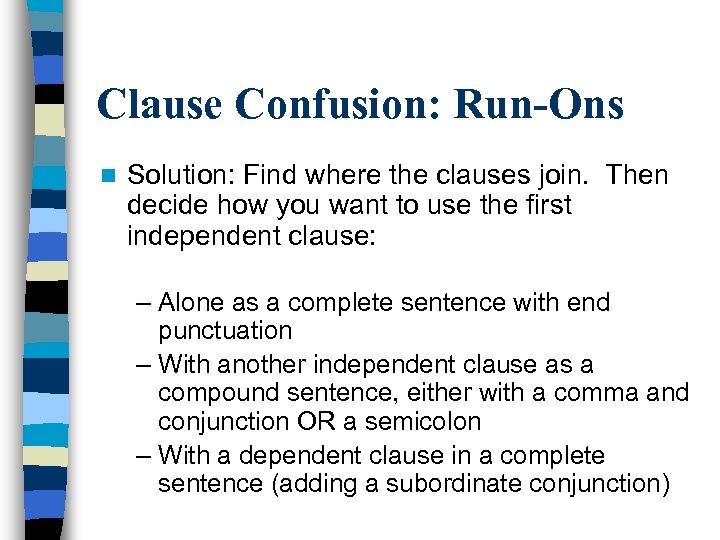
Clause Confusion: Run-Ons n Solution: Find where the clauses join. Then decide how you want to use the first independent clause: – Alone as a complete sentence with end punctuation – With another independent clause as a compound sentence, either with a comma and conjunction OR a semicolon – With a dependent clause in a complete sentence (adding a subordinate conjunction)

Clause Confusion: Run-Ons Incorrect: I need the insurance paperwork back as soon as possible the coverage begins early next month. Correct: I need the insurance paperwork back as soon as possible. The coverage begins early next month. Incorrect: But we discussed last week you will have full coverage for yourself and family. Correct: But as we discussed last week, you will have full coverage for yourself and family.

Clause Confusion: Sentence Fragments Problem: Phrases are used as independent clauses OR dependent clauses are used alone, without an independent clause n Cause: Fragments are not complete sentences or have subordinating conjunctions without anything to modify. n Incorrect: The patient uninsured at this time and now unable to make payment. Incorrect: Since the due date is past and collection is requested.
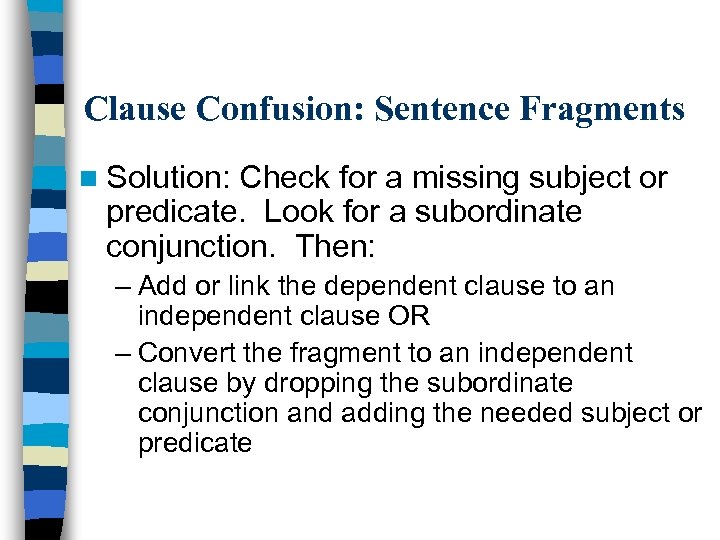
Clause Confusion: Sentence Fragments n Solution: Check for a missing subject or predicate. Look for a subordinate conjunction. Then: – Add or link the dependent clause to an independent clause OR – Convert the fragment to an independent clause by dropping the subordinate conjunction and adding the needed subject or predicate
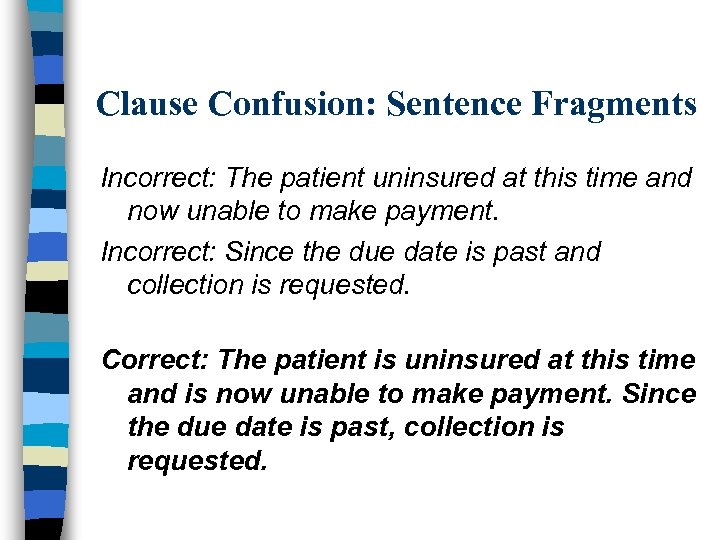
Clause Confusion: Sentence Fragments Incorrect: The patient uninsured at this time and now unable to make payment. Incorrect: Since the due date is past and collection is requested. Correct: The patient is uninsured at this time and is now unable to make payment. Since the due date is past, collection is requested.
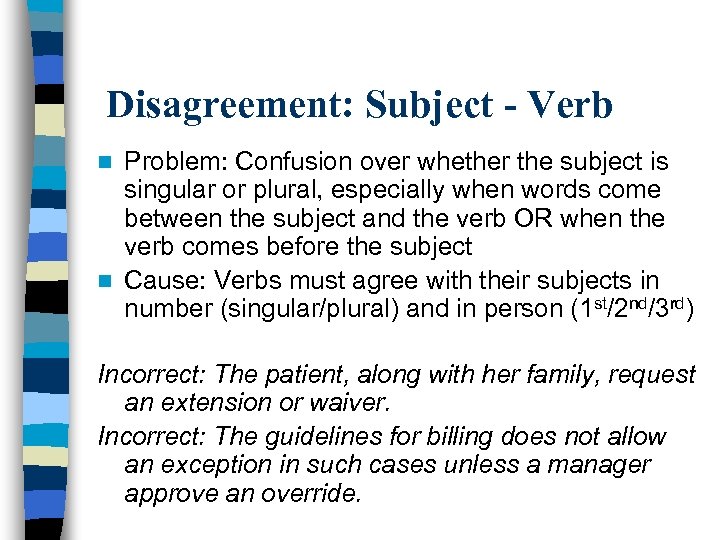
Disagreement: Subject - Verb Problem: Confusion over whether the subject is singular or plural, especially when words come between the subject and the verb OR when the verb comes before the subject n Cause: Verbs must agree with their subjects in number (singular/plural) and in person (1 st/2 nd/3 rd) n Incorrect: The patient, along with her family, request an extension or waiver. Incorrect: The guidelines for billing does not allow an exception in such cases unless a manager approve an override.
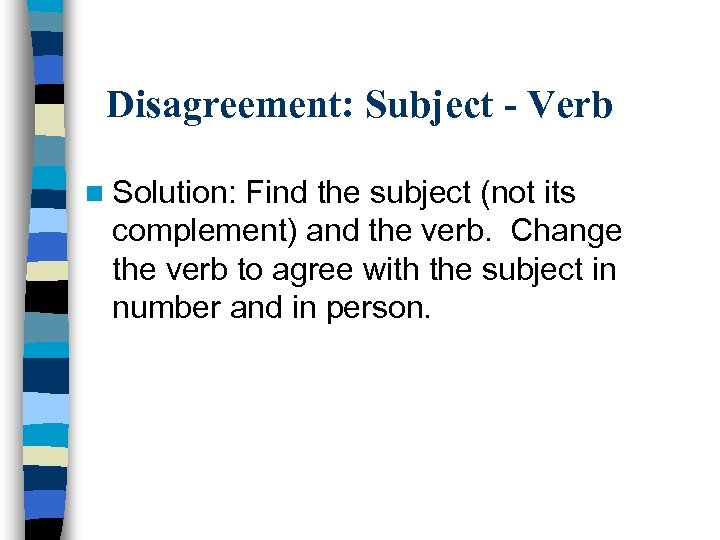
Disagreement: Subject - Verb n Solution: Find the subject (not its complement) and the verb. Change the verb to agree with the subject in number and in person.
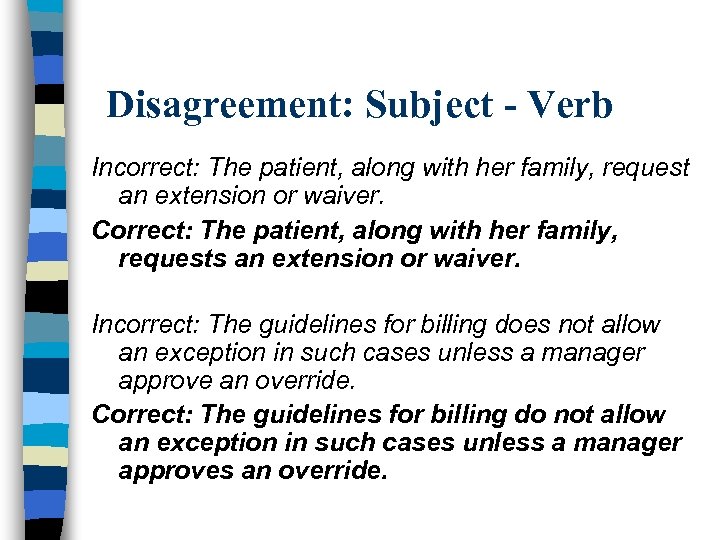
Disagreement: Subject - Verb Incorrect: The patient, along with her family, request an extension or waiver. Correct: The patient, along with her family, requests an extension or waiver. Incorrect: The guidelines for billing does not allow an exception in such cases unless a manager approve an override. Correct: The guidelines for billing do not allow an exception in such cases unless a manager approves an override.

Disagreement: Compound Subjects Problem: Confusion over whether to treat compound subjects as singular or plural. n Cause: Different conjunctions result in different treatment. Also, “either” and “neither” may be used alone a indefinite pronouns rather than conjunctions. n Incorrect: Dr. Williams, Dr. Smith and Dr. Jones wants to participate in this week’s training. Incorrect: Neither Dr. Williams nor the others has their application completed. Incorrect: However, everyone have submitted the registration fee.
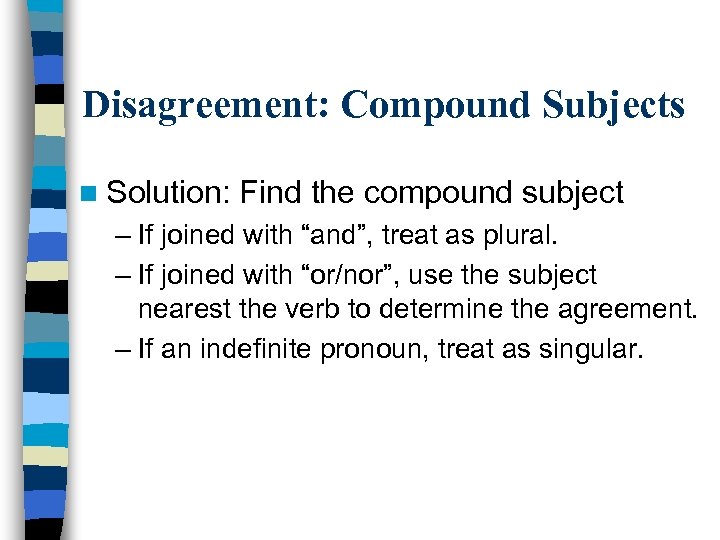
Disagreement: Compound Subjects n Solution: Find the compound subject – If joined with “and”, treat as plural. – If joined with “or/nor”, use the subject nearest the verb to determine the agreement. – If an indefinite pronoun, treat as singular.
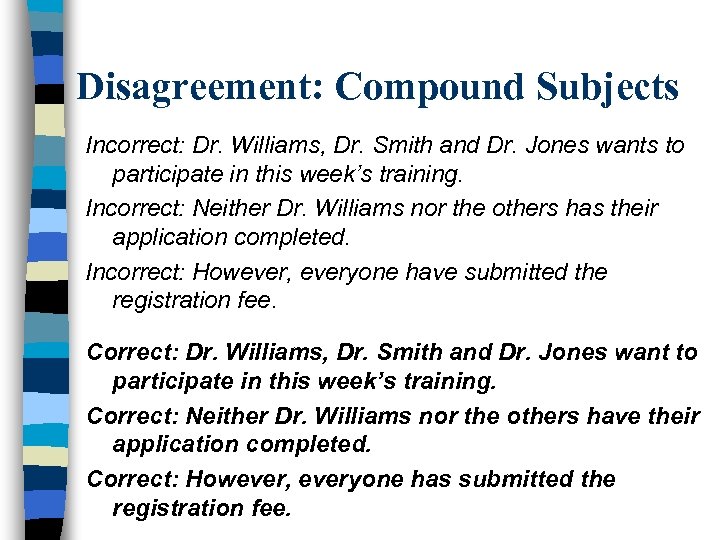
Disagreement: Compound Subjects Incorrect: Dr. Williams, Dr. Smith and Dr. Jones wants to participate in this week’s training. Incorrect: Neither Dr. Williams nor the others has their application completed. Incorrect: However, everyone have submitted the registration fee. Correct: Dr. Williams, Dr. Smith and Dr. Jones want to participate in this week’s training. Correct: Neither Dr. Williams nor the others have their application completed. Correct: However, everyone has submitted the registration fee.
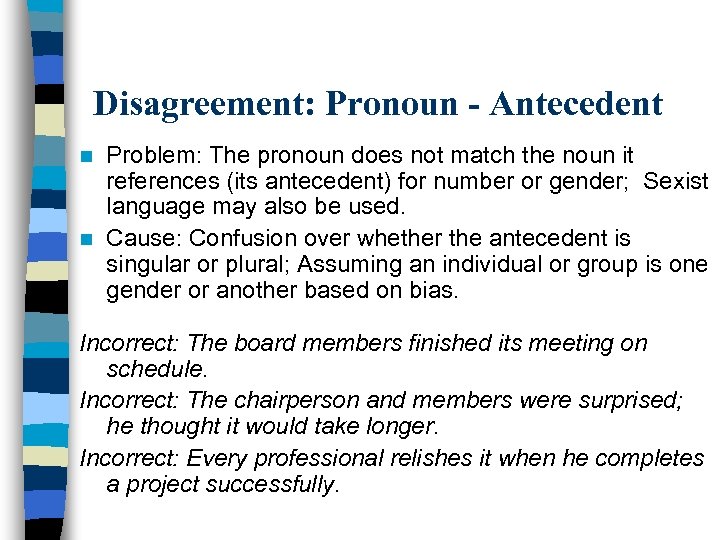
Disagreement: Pronoun - Antecedent Problem: The pronoun does not match the noun it references (its antecedent) for number or gender; Sexist language may also be used. n Cause: Confusion over whether the antecedent is singular or plural; Assuming an individual or group is one gender or another based on bias. n Incorrect: The board members finished its meeting on schedule. Incorrect: The chairperson and members were surprised; he thought it would take longer. Incorrect: Every professional relishes it when he completes a project successfully.

Disagreement: Pronoun - Antecedent Solution: Find the antecedent. Ensure that the pronoun matches for number and gender. – Treat indefinite antecedents (e. g. anyone, somebody), generic nouns and collective nouns as singular. – Treat compound antecedents connected by “and” as plural. – For compound antecedents connected by “or/nor”, make the pronoun agree with the nearer antecedent – Use gender neutral pronouns when possible n Hint: It may be easier to change the antecedent than the pronoun n

Disagreement: Pronoun - Antecedent Incorrect: The board members finished its meeting on schedule. Incorrect: The chairperson and members were surprised; he thought it would take longer. Incorrect: Every professional relishes it when he completes a project successfully. Correct: The board members finished their meeting on schedule. Correct: The chairperson and members were surprised; they thought it would take longer. Correct: Professionals relish it when they complete a project successfully.

Disagreement – Ambiguous Pronouns Problem: It is unclear which antecedent a pronoun references n Cause: There a number of possible causes – More than one antecedent is present – The pronoun is not close to the antecedent – An implied antecedent is referenced – “That” or “which” is used to refer to persons n Incorrect: Jill had a fight at work and had to meet with her supervisor, Joan, about it. It made her mad. Incorrect: Joan didn’t know which was to blame, Jill or her co-worker.
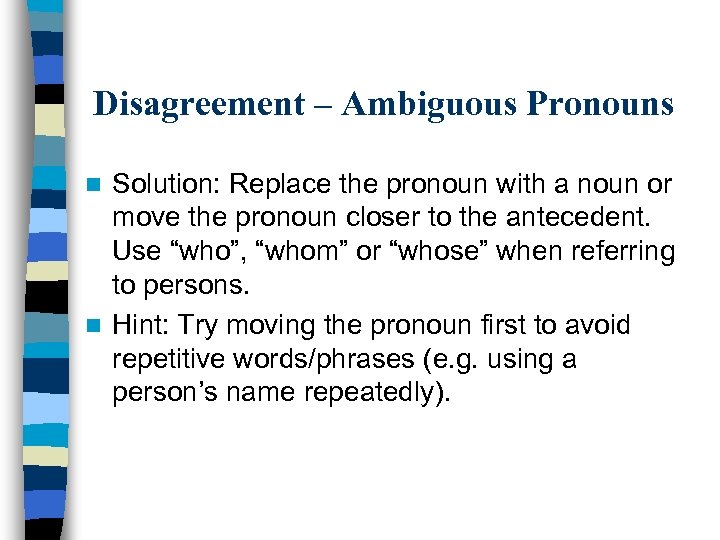
Disagreement – Ambiguous Pronouns Solution: Replace the pronoun with a noun or move the pronoun closer to the antecedent. Use “who”, “whom” or “whose” when referring to persons. n Hint: Try moving the pronoun first to avoid repetitive words/phrases (e. g. using a person’s name repeatedly). n
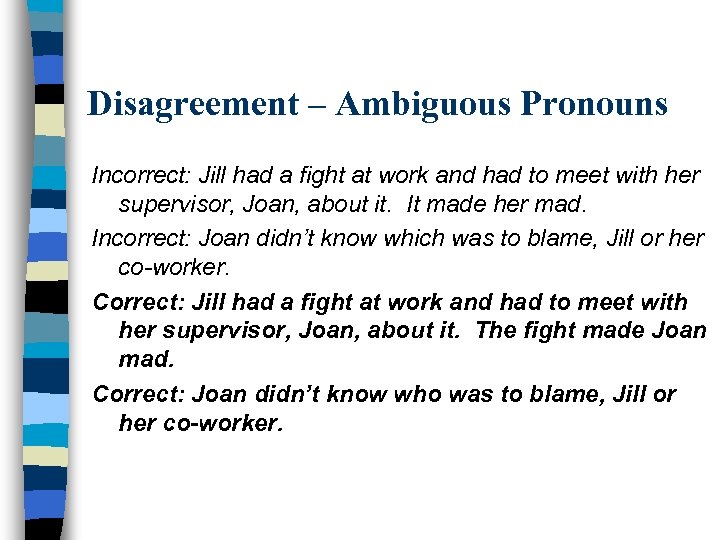
Disagreement – Ambiguous Pronouns Incorrect: Jill had a fight at work and had to meet with her supervisor, Joan, about it. It made her mad. Incorrect: Joan didn’t know which was to blame, Jill or her co-worker. Correct: Jill had a fight at work and had to meet with her supervisor, Joan, about it. The fight made Joan mad. Correct: Joan didn’t know who was to blame, Jill or her co-worker.
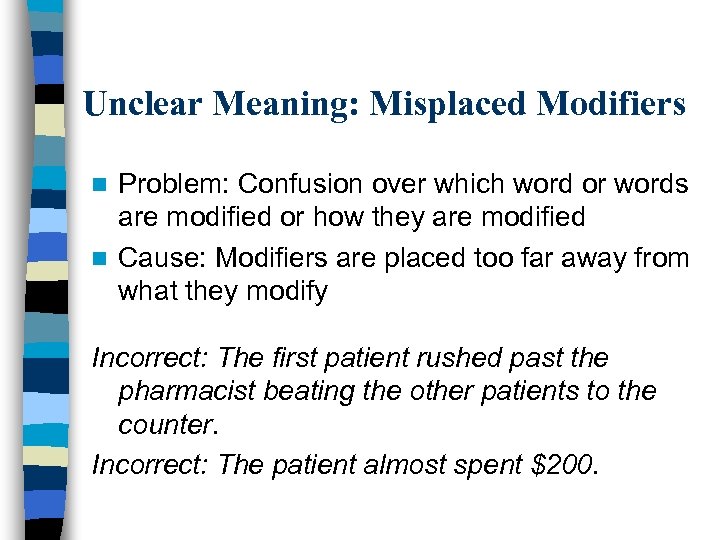
Unclear Meaning: Misplaced Modifiers Problem: Confusion over which word or words are modified or how they are modified n Cause: Modifiers are placed too far away from what they modify n Incorrect: The first patient rushed past the pharmacist beating the other patients to the counter. Incorrect: The patient almost spent $200.
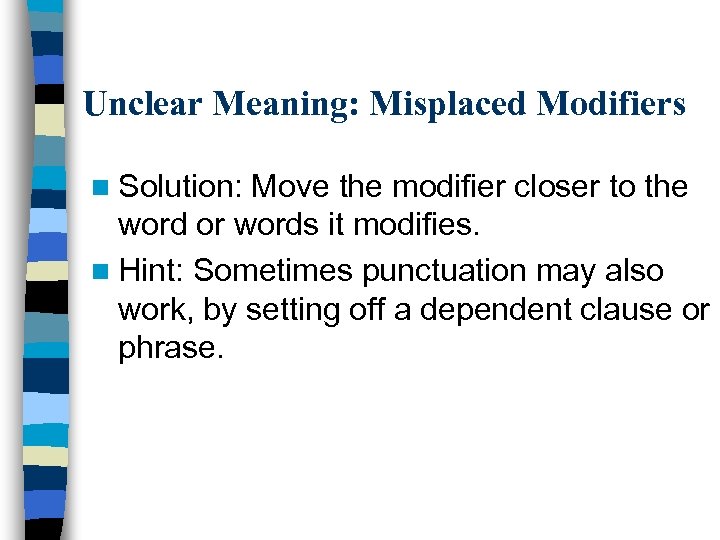
Unclear Meaning: Misplaced Modifiers n Solution: Move the modifier closer to the word or words it modifies. n Hint: Sometimes punctuation may also work, by setting off a dependent clause or phrase.
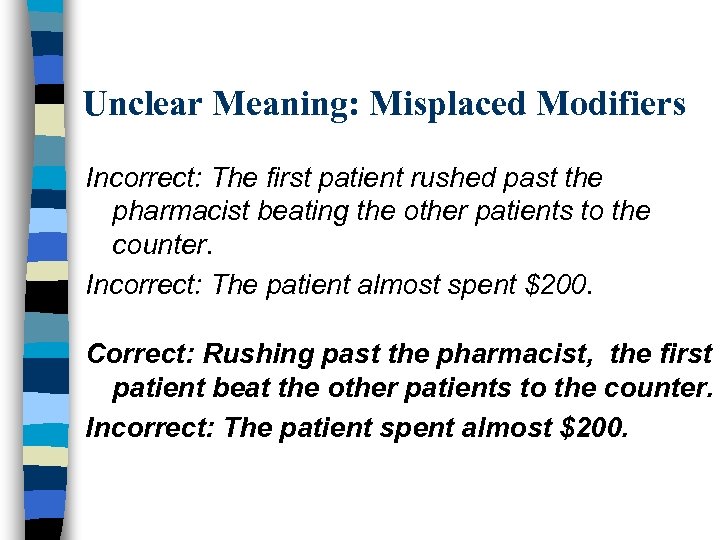
Unclear Meaning: Misplaced Modifiers Incorrect: The first patient rushed past the pharmacist beating the other patients to the counter. Incorrect: The patient almost spent $200. Correct: Rushing past the pharmacist, the first patient beat the other patients to the counter. Incorrect: The patient spent almost $200.

Unclear Meaning: Dangling Modifiers Problem: Introductory or closing modifying phrases that do not name the subject modified. n Cause: The modifier implies the wrong subject is modified. n Incorrect: Writing quickly, the prescription was completed without looking up. Incorrect: The patient left the doctor flying out of the room.

Unclear Meaning: Dangling Modifiers n Solution: The sentence must be rewritten. (Moving the modifier will not help. ) – Name the word/words being modified in the subject of the independent clause OR – Place the word/words being modified within the modifying phrase.

Unclear Meaning: Dangling Modifiers Incorrect: Writing quickly, the prescription was completed without looking up. Incorrect: The patient left the doctor flying out of the room. Correct: Writing quickly, the doctor completed the prescription without looking up. Correct: The patient flew out of the room as he left the doctor.
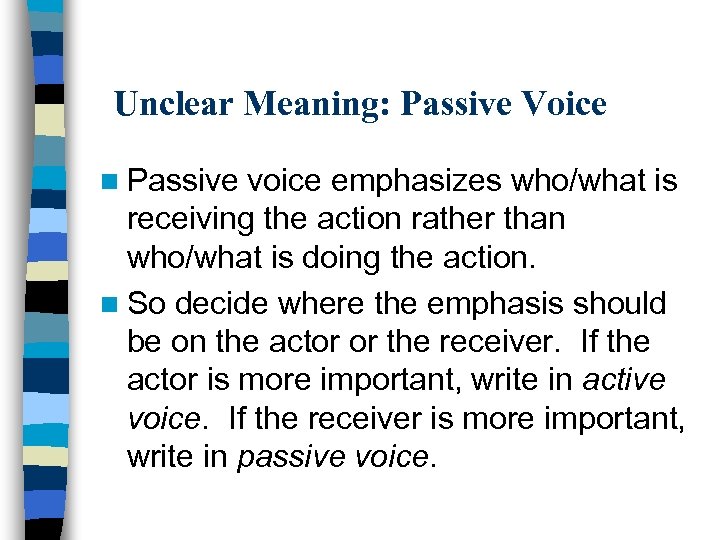
Unclear Meaning: Passive Voice n Passive voice emphasizes who/what is receiving the action rather than who/what is doing the action. n So decide where the emphasis should be on the actor or the receiver. If the actor is more important, write in active voice. If the receiver is more important, write in passive voice.
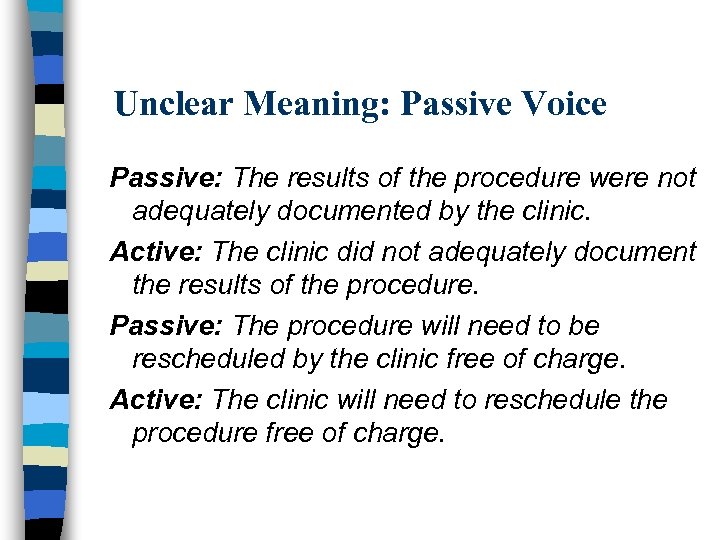
Unclear Meaning: Passive Voice Passive: The results of the procedure were not adequately documented by the clinic. Active: The clinic did not adequately document the results of the procedure. Passive: The procedure will need to be rescheduled by the clinic free of charge. Active: The clinic will need to reschedule the procedure free of charge.
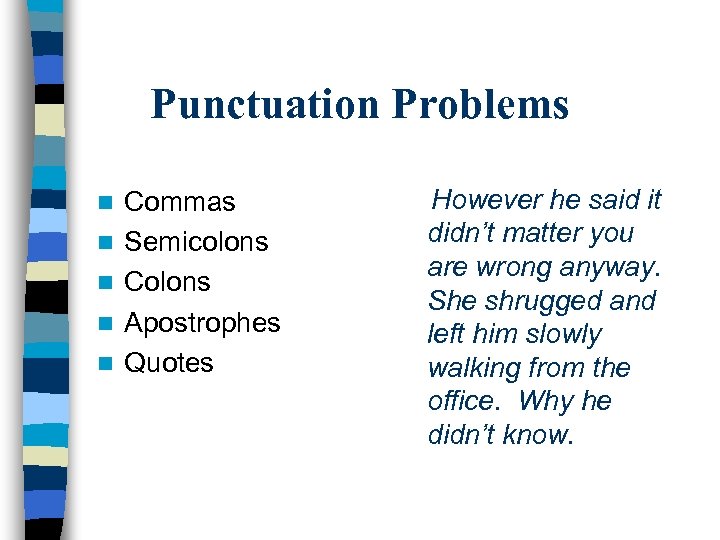
Punctuation Problems n n n Commas Semicolons Colons Apostrophes Quotes However he said it didn’t matter you are wrong anyway. She shrugged and left him slowly walking from the office. Why he didn’t know.
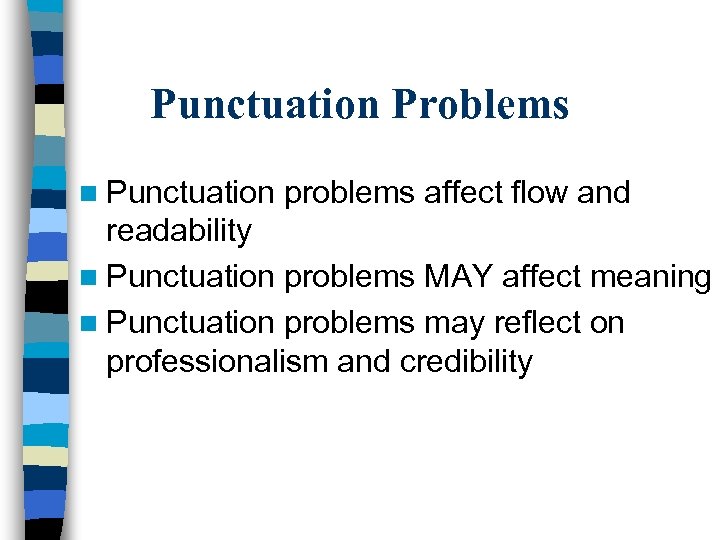
Punctuation Problems n Punctuation problems affect flow and readability n Punctuation problems MAY affect meaning n Punctuation problems may reflect on professionalism and credibility
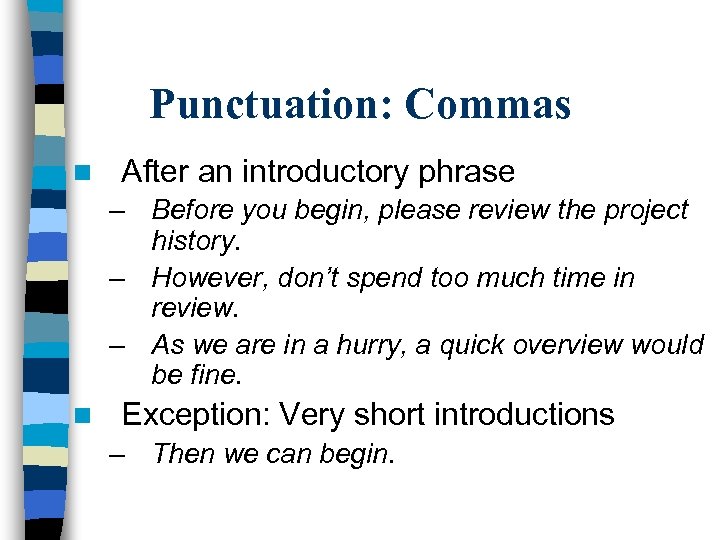
Punctuation: Commas n After an introductory phrase – Before you begin, please review the project history. – However, don’t spend too much time in review. – As we are in a hurry, a quick overview would be fine. n Exception: Very short introductions – Then we can begin.
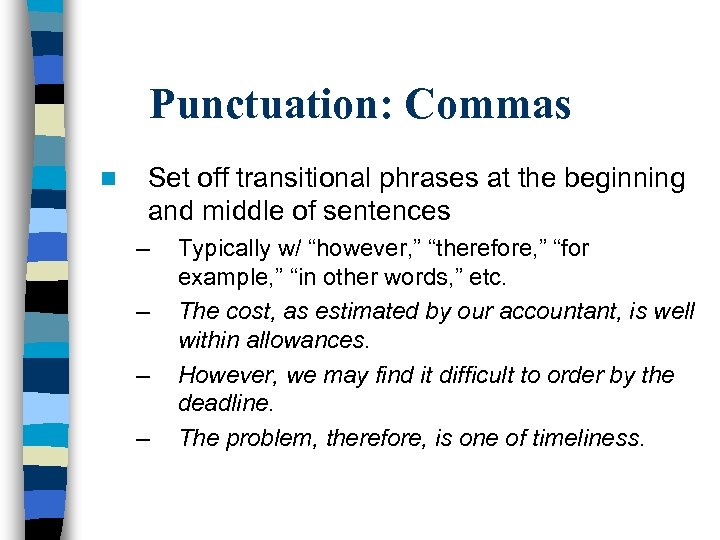
Punctuation: Commas n Set off transitional phrases at the beginning and middle of sentences – – Typically w/ “however, ” “therefore, ” “for example, ” “in other words, ” etc. The cost, as estimated by our accountant, is well within allowances. However, we may find it difficult to order by the deadline. The problem, therefore, is one of timeliness.
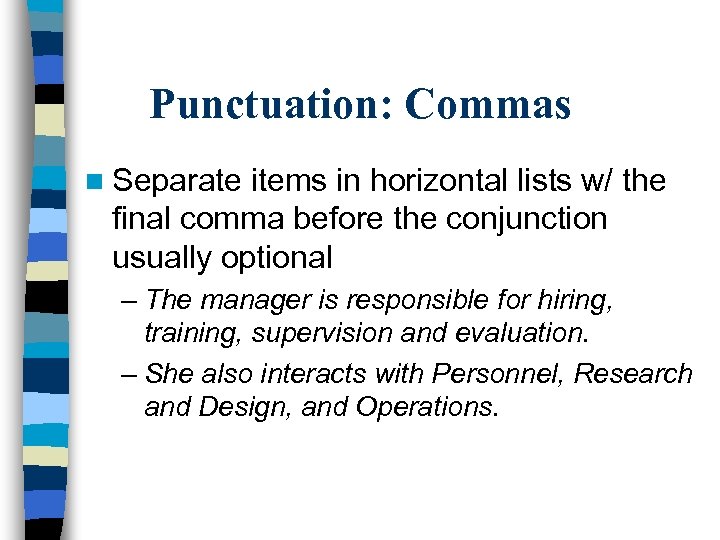
Punctuation: Commas n Separate items in horizontal lists w/ the final comma before the conjunction usually optional – The manager is responsible for hiring, training, supervision and evaluation. – She also interacts with Personnel, Research and Design, and Operations.
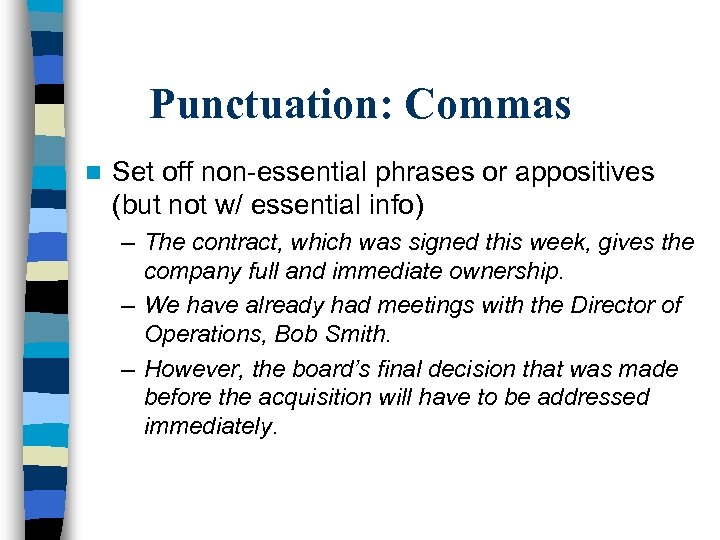
Punctuation: Commas n Set off non-essential phrases or appositives (but not w/ essential info) – The contract, which was signed this week, gives the company full and immediate ownership. – We have already had meetings with the Director of Operations, Bob Smith. – However, the board’s final decision that was made before the acquisition will have to be addressed immediately.
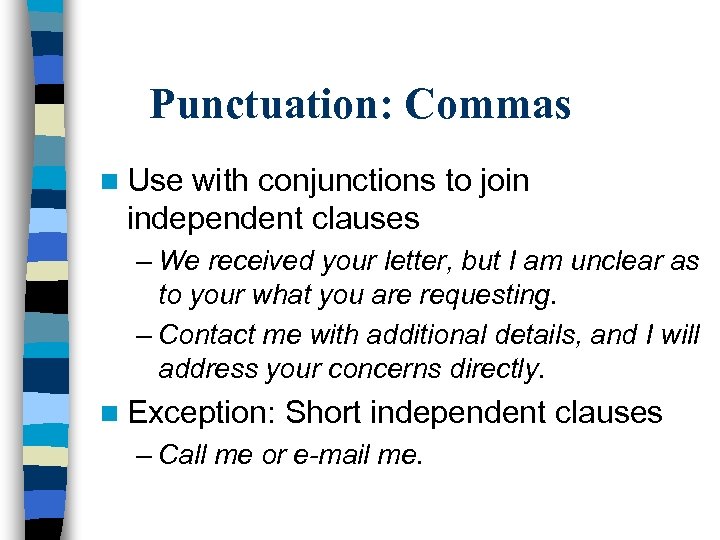
Punctuation: Commas n Use with conjunctions to join independent clauses – We received your letter, but I am unclear as to your what you are requesting. – Contact me with additional details, and I will address your concerns directly. n Exception: Short independent clauses – Call me or e-mail me.
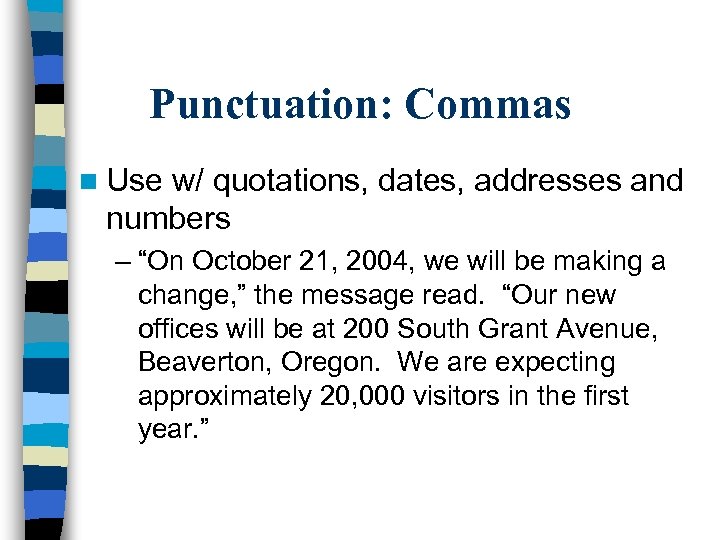
Punctuation: Commas n Use w/ quotations, dates, addresses and numbers – “On October 21, 2004, we will be making a change, ” the message read. “Our new offices will be at 200 South Grant Avenue, Beaverton, Oregon. We are expecting approximately 20, 000 visitors in the first year. ”

Punctuation: Semicolons n Join independent clauses w/out a conjunction – It seemed it would last forever; it didn’t. – Some do; some don’t. n Use to separate items in a series that already includes punctuation – Several world leaders participated including George Bush, President of the U. S. ; Tony Blair, Prime Minister of England; and Jacques Chirac, President of France. – The witness heard various people shout: “Hey!”; “Stop!”; and “Don’t do that!”
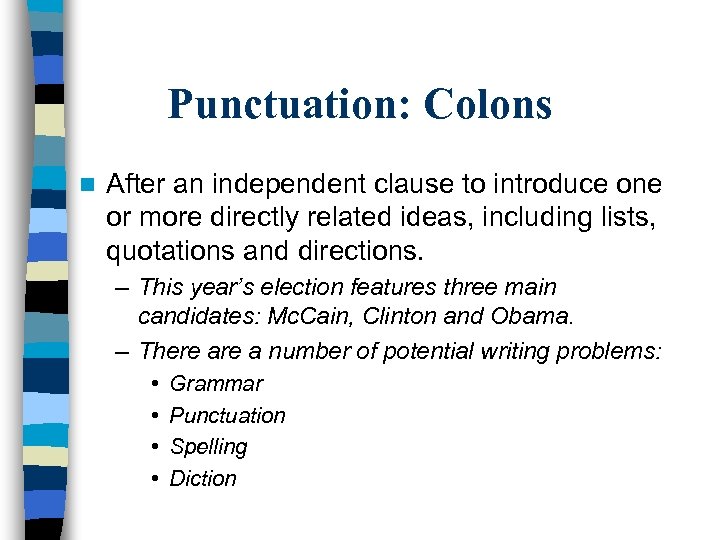
Punctuation: Colons n After an independent clause to introduce one or more directly related ideas, including lists, quotations and directions. – This year’s election features three main candidates: Mc. Cain, Clinton and Obama. – There a number of potential writing problems: • • Grammar Punctuation Spelling Diction
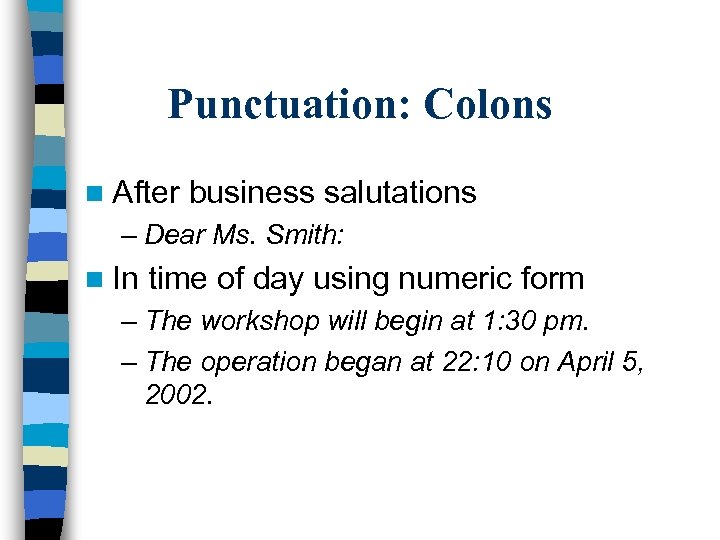
Punctuation: Colons n After business salutations – Dear Ms. Smith: n In time of day using numeric form – The workshop will begin at 1: 30 pm. – The operation began at 22: 10 on April 5, 2002.
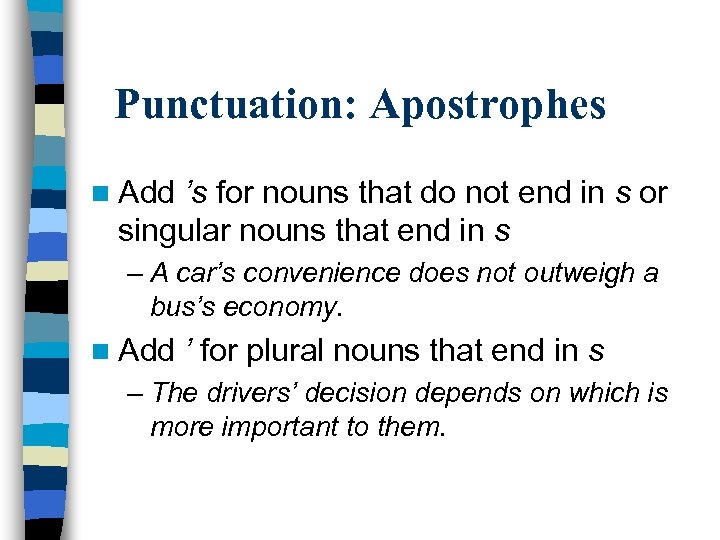
Punctuation: Apostrophes n Add ’s for nouns that do not end in s or singular nouns that end in s – A car’s convenience does not outweigh a bus’s economy. n Add ’ for plural nouns that end in s – The drivers’ decision depends on which is more important to them.

Punctuation: Apostrophes n Add ’ or ’s with the last element in joint possession or compound nouns – John and Mary’s house should bring a good price. n Exception: To show individual possession, make all possessive – However, John’s and Mary’s willingness to sell is a big question.
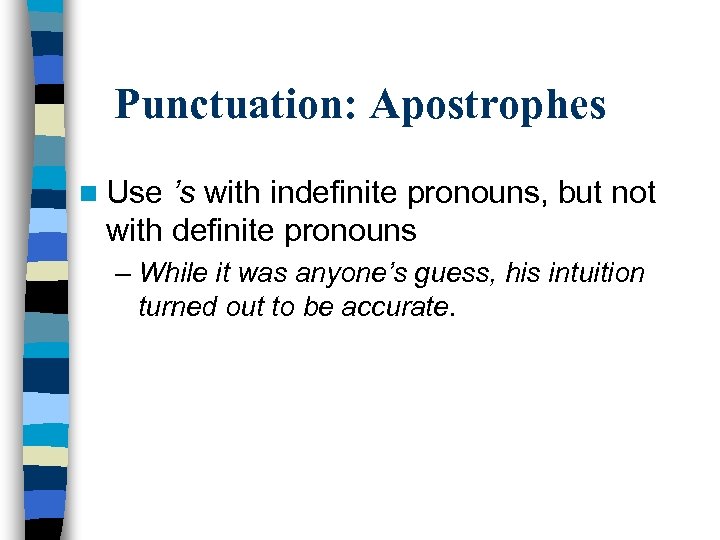
Punctuation: Apostrophes n Use ’s with indefinite pronouns, but not with definite pronouns – While it was anyone’s guess, his intuition turned out to be accurate.

Punctuation: Quotations n n n Quotation marks set off direct quotes Commas and periods go inside quotation marks Colons and semicolons go outside quotation marks Question and exclamation marks go inside if part of the quoted material. Capitalize beginnings of quotes UNLESS the quote is blended into the sentence.
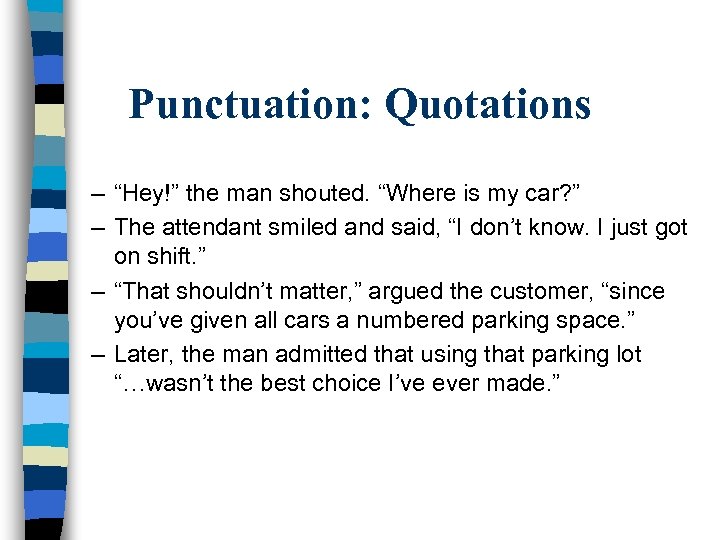
Punctuation: Quotations – “Hey!” the man shouted. “Where is my car? ” – The attendant smiled and said, “I don’t know. I just got on shift. ” – “That shouldn’t matter, ” argued the customer, “since you’ve given all cars a numbered parking space. ” – Later, the man admitted that using that parking lot “…wasn’t the best choice I’ve ever made. ”

Punctuation: Quotations n Use the ellipsis mark to indicate material not included – According to Smith, “The results of the study…were surprising and unexpected. ” n Use the bracket to indicate material added – Smith attributes this to “the varying methods [used by three different research teams] to gather and analyze the data. ” – “The next project, ” the director stated, “will not have such varience [sic] as new controls are in place. ”
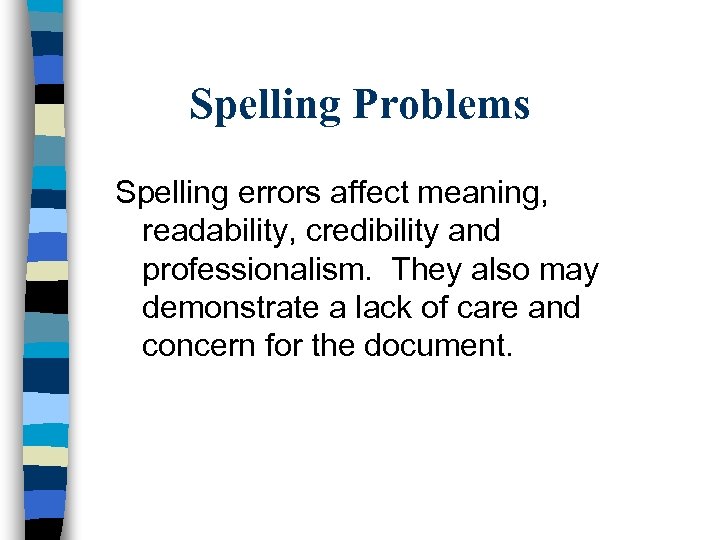
Spelling Problems Spelling errors affect meaning, readability, credibility and professionalism. They also may demonstrate a lack of care and concern for the document.

Spelling: I before E n I before E … – Achievement, patient, chief n Except after C … – Perceive, receipt, receive n And in the sound “ay” as in hay – Neighbor, weigh, freight n Exceptions – Either, neither, height, foreign, leisure, seize, weird
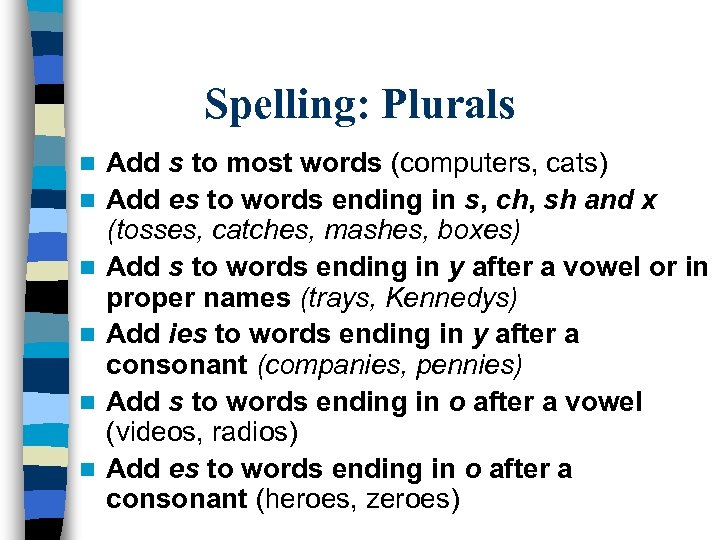
Spelling: Plurals n n n Add s to most words (computers, cats) Add es to words ending in s, ch, sh and x (tosses, catches, mashes, boxes) Add s to words ending in y after a vowel or in proper names (trays, Kennedys) Add ies to words ending in y after a consonant (companies, pennies) Add s to words ending in o after a vowel (videos, radios) Add es to words ending in o after a consonant (heroes, zeroes)
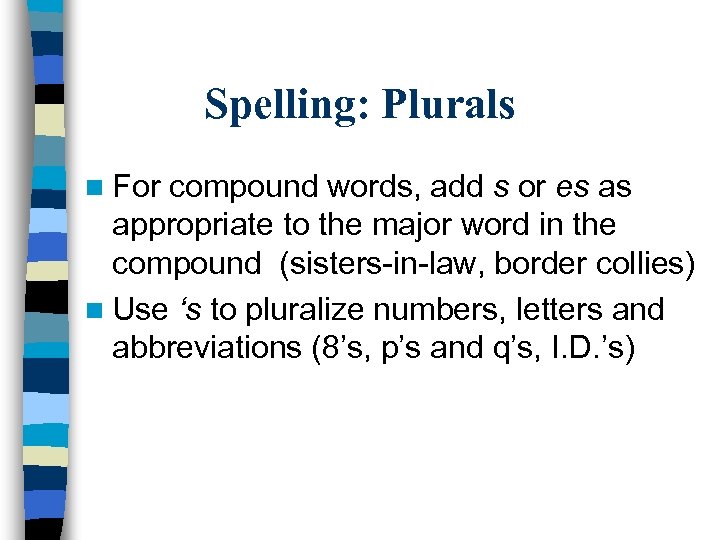
Spelling: Plurals n For compound words, add s or es as appropriate to the major word in the compound (sisters-in-law, border collies) n Use ‘s to pluralize numbers, letters and abbreviations (8’s, p’s and q’s, I. D. ’s)
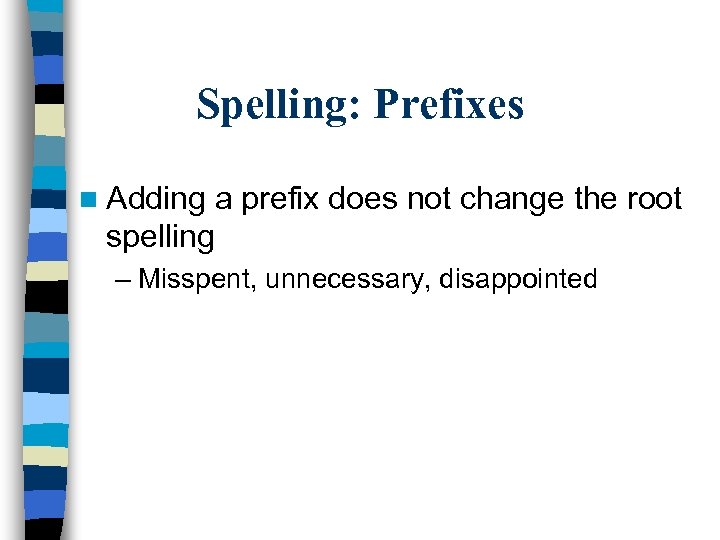
Spelling: Prefixes n Adding a prefix does not change the root spelling – Misspent, unnecessary, disappointed
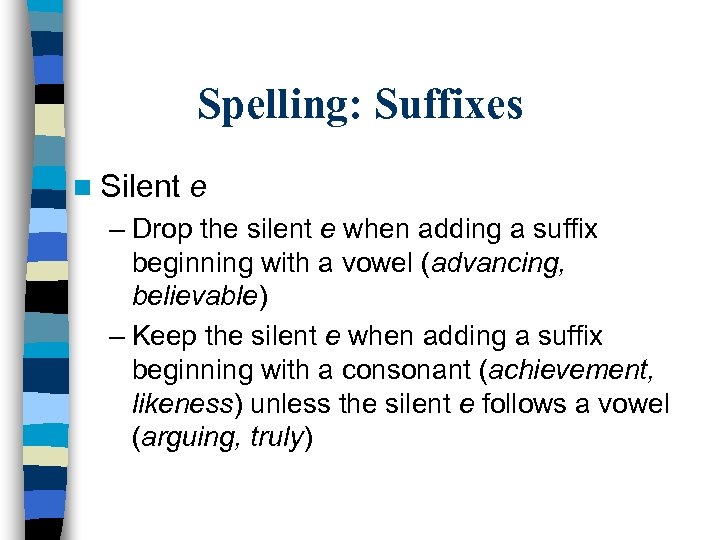
Spelling: Suffixes n Silent e – Drop the silent e when adding a suffix beginning with a vowel (advancing, believable) – Keep the silent e when adding a suffix beginning with a consonant (achievement, likeness) unless the silent e follows a vowel (arguing, truly)
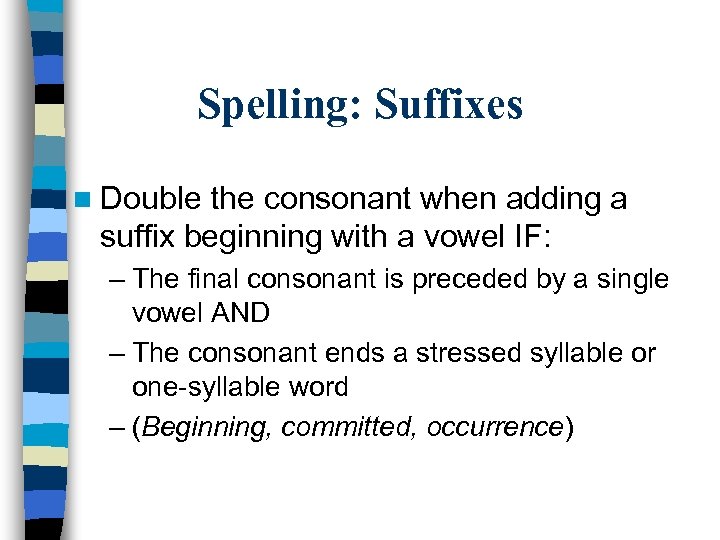
Spelling: Suffixes n Double the consonant when adding a suffix beginning with a vowel IF: – The final consonant is preceded by a single vowel AND – The consonant ends a stressed syllable or one-syllable word – (Beginning, committed, occurrence)
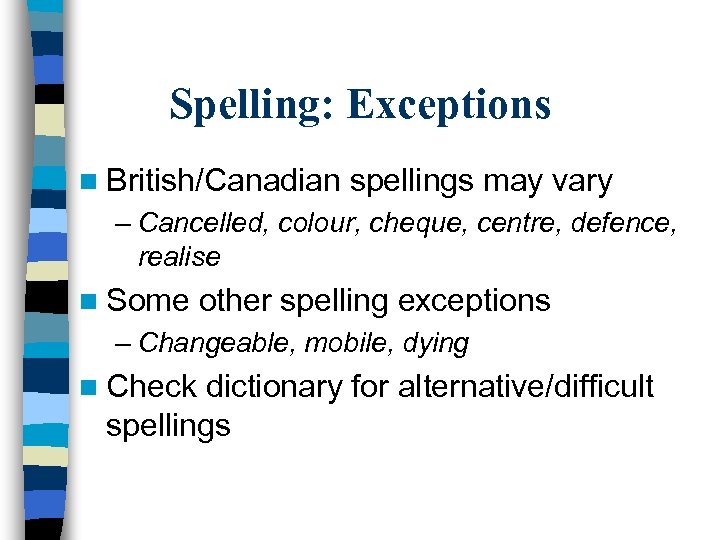
Spelling: Exceptions n British/Canadian spellings may vary – Cancelled, colour, cheque, centre, defence, realise n Some other spelling exceptions – Changeable, mobile, dying n Check dictionary for alternative/difficult spellings

Proofreading Purpose: Locate and mark errors and needed changes in a document. n n n n Approach w/ “fresh eyes” Know why you are proofreading Proof for the audience Mark problems; don’t fix them Look for needed changes only Read both silently and aloud Proofread in “chunks” Proof multiple times

Proofreading for Revision Purpose: Check content and order for clarification or restatement n n n n Read for overview Determine purpose of the document Find the main point or thesis Find the evidence or details Check paragraph order and “weight” Proof paragraphs for relevance and flow Repeat as necessary
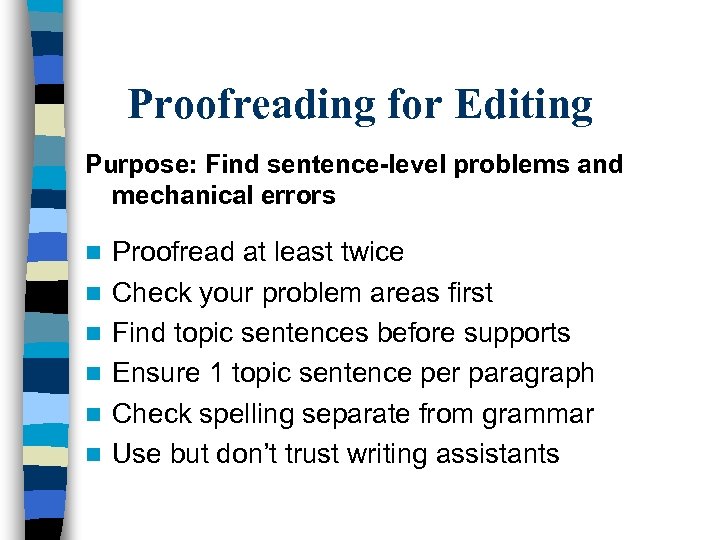
Proofreading for Editing Purpose: Find sentence-level problems and mechanical errors n n n Proofread at least twice Check your problem areas first Find topic sentences before supports Ensure 1 topic sentence per paragraph Check spelling separate from grammar Use but don’t trust writing assistants
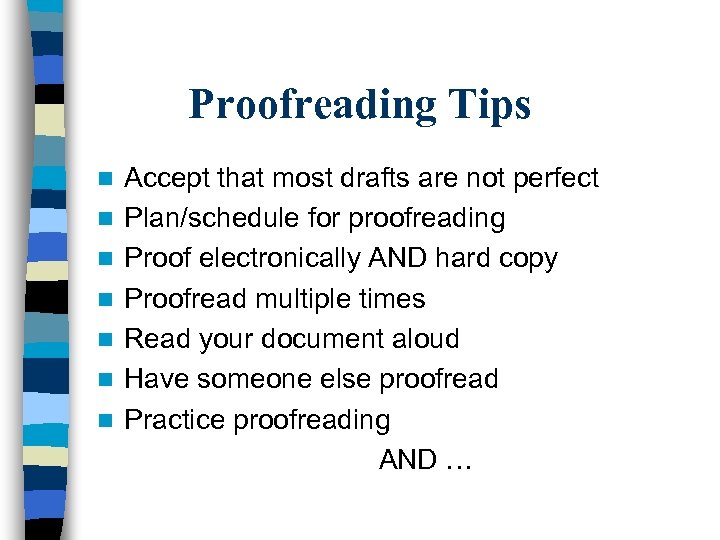
Proofreading Tips n n n n Accept that most drafts are not perfect Plan/schedule for proofreading Proof electronically AND hard copy Proofread multiple times Read your document aloud Have someone else proofread Practice proofreading AND …
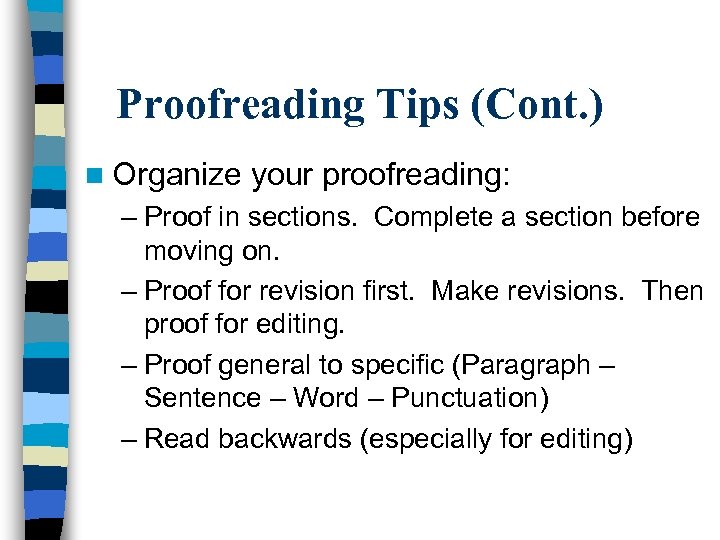
Proofreading Tips (Cont. ) n Organize your proofreading: – Proof in sections. Complete a section before moving on. – Proof for revision first. Make revisions. Then proof for editing. – Proof general to specific (Paragraph – Sentence – Word – Punctuation) – Read backwards (especially for editing)
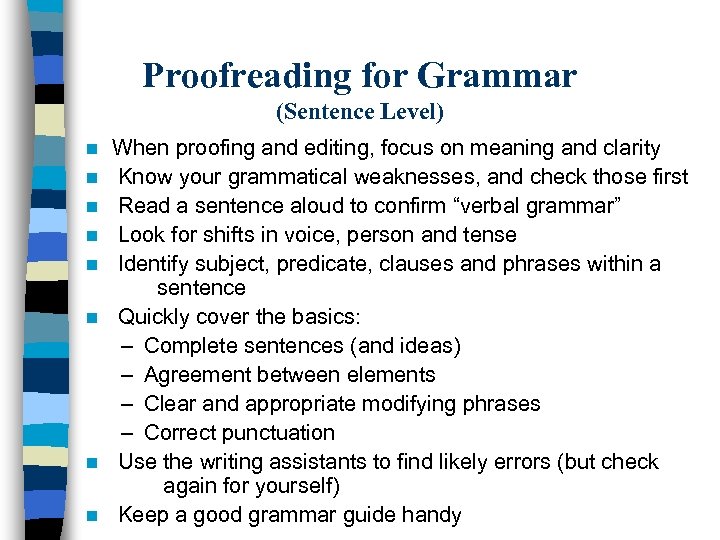
Proofreading for Grammar (Sentence Level) n n n n When proofing and editing, focus on meaning and clarity Know your grammatical weaknesses, and check those first Read a sentence aloud to confirm “verbal grammar” Look for shifts in voice, person and tense Identify subject, predicate, clauses and phrases within a sentence Quickly cover the basics: – Complete sentences (and ideas) – Agreement between elements – Clear and appropriate modifying phrases – Correct punctuation Use the writing assistants to find likely errors (but check again for yourself) Keep a good grammar guide handy
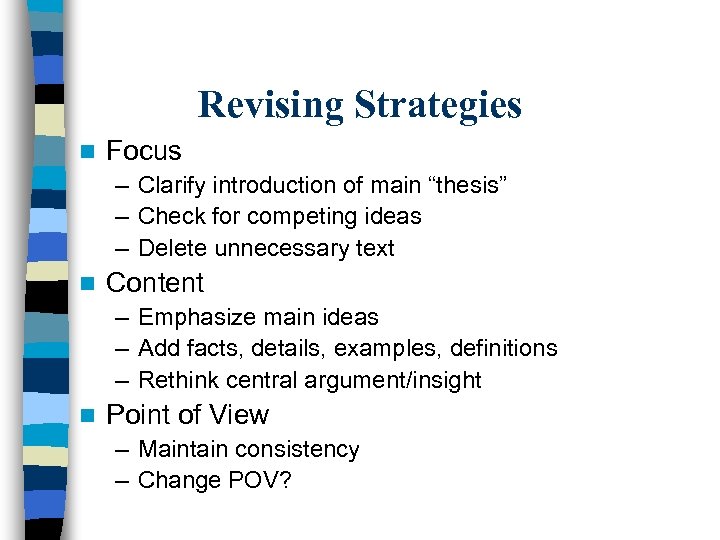
Revising Strategies n Focus – Clarify introduction of main “thesis” – Check for competing ideas – Delete unnecessary text n Content – Emphasize main ideas – Add facts, details, examples, definitions – Rethink central argument/insight n Point of View – Maintain consistency – Change POV?
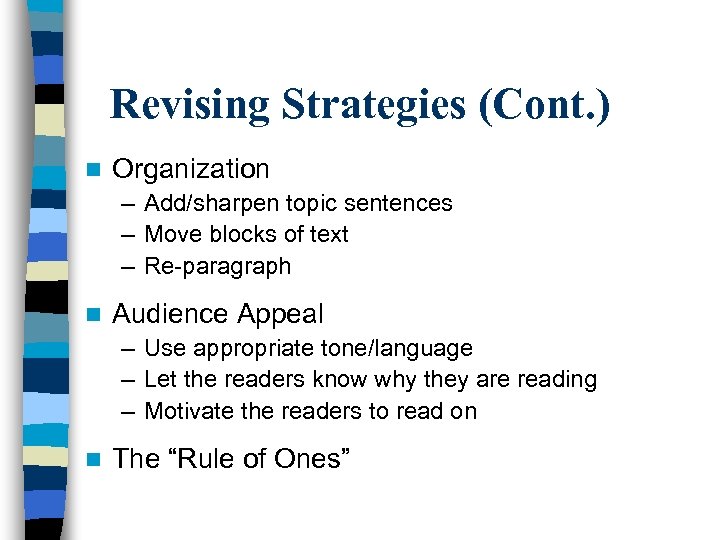
Revising Strategies (Cont. ) n Organization – Add/sharpen topic sentences – Move blocks of text – Re-paragraph n Audience Appeal – Use appropriate tone/language – Let the readers know why they are reading – Motivate the readers to read on n The “Rule of Ones”

Editing Strategies: Movement n Check paragraphs – Topic sentence followed by support sentences – Transitional sentences/phrases n Arrange paragraphs appropriately – – n Time (chronological, narrative, process) Space (descriptive, setting) Dramatic (build to climax, back load) Logic (argument, essay) Link ideas
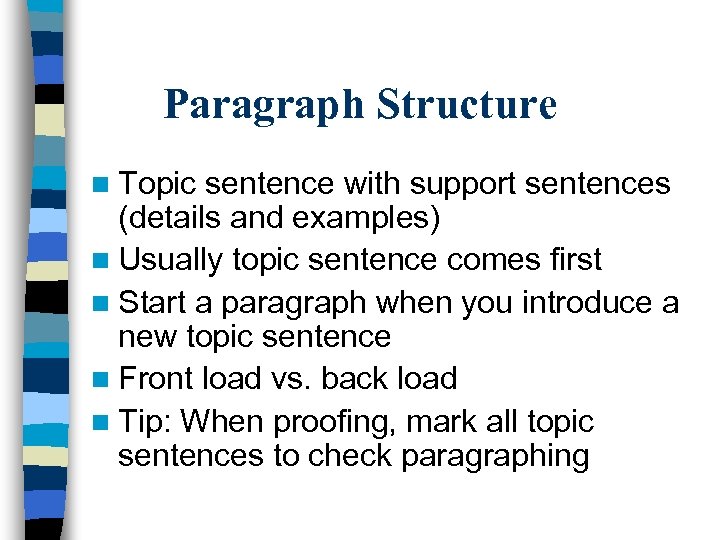
Paragraph Structure n Topic sentence with support sentences (details and examples) n Usually topic sentence comes first n Start a paragraph when you introduce a new topic sentence n Front load vs. back load n Tip: When proofing, mark all topic sentences to check paragraphing
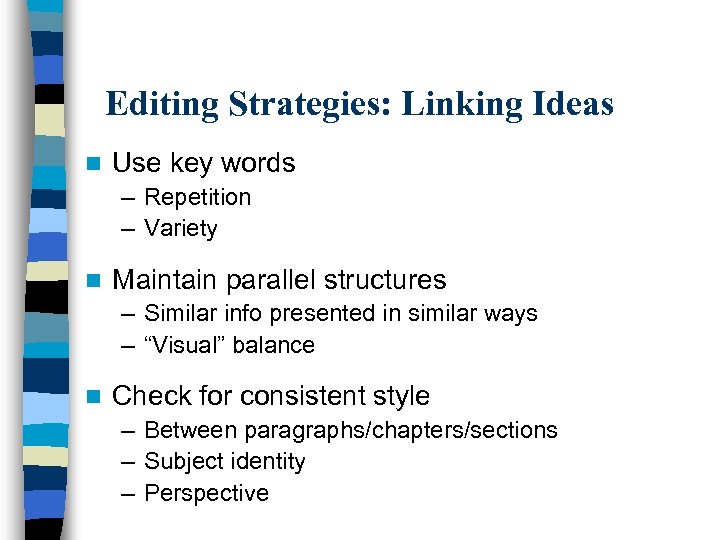
Editing Strategies: Linking Ideas n Use key words – Repetition – Variety n Maintain parallel structures – Similar info presented in similar ways – “Visual” balance n Check for consistent style – Between paragraphs/chapters/sections – Subject identity – Perspective

Editing Strategies: Transitions Use “roadmap” sentences/paragraphs n Choose appropriate phrases n – Addition (and, also, further, in addition to, moreover, next, too) – Compare (also, in the same manner, in this way, likewise, similarly) – Contrast (although, but, even though, however, in contrast, nevertheless, still) – Summary (In conclusion, in other words, in short, therefore, to sum up) – Relation [time, order, place] (after, as, during, finally, later, when, first, second, next, last, above, beyond, farther on, near, opposite) – Logic (as a result, consequently, if, since, so, therefore, thus)
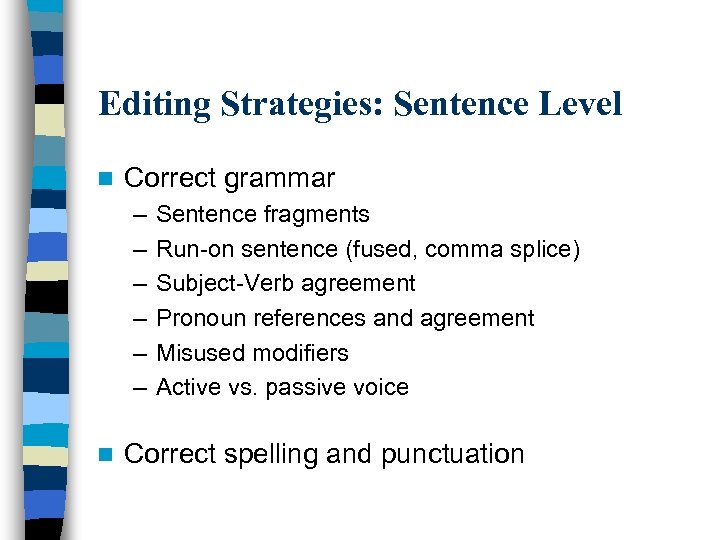
Editing Strategies: Sentence Level n Correct grammar – – – n Sentence fragments Run-on sentence (fused, comma splice) Subject-Verb agreement Pronoun references and agreement Misused modifiers Active vs. passive voice Correct spelling and punctuation
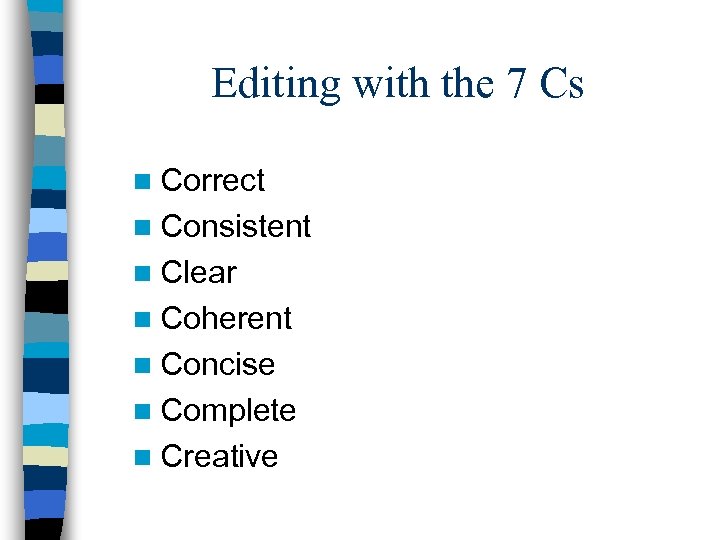
Editing with the 7 Cs n Correct n Consistent n Clear n Coherent n Concise n Complete n Creative
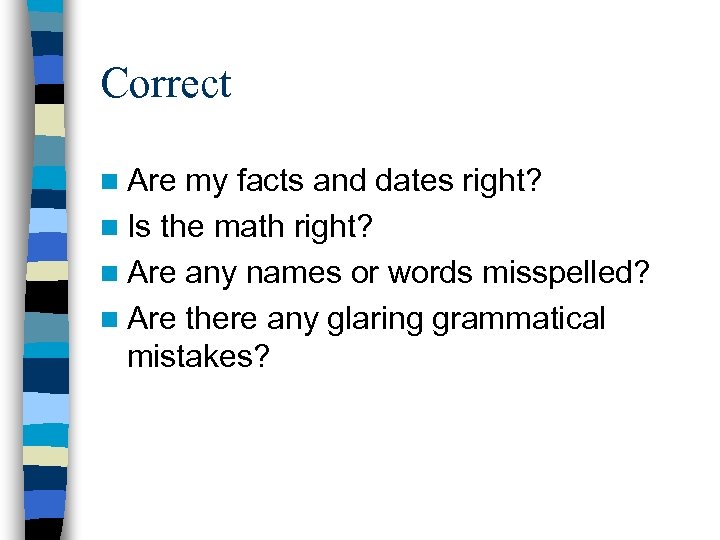
Correct n Are my facts and dates right? n Is the math right? n Are any names or words misspelled? n Are there any glaring grammatical mistakes?
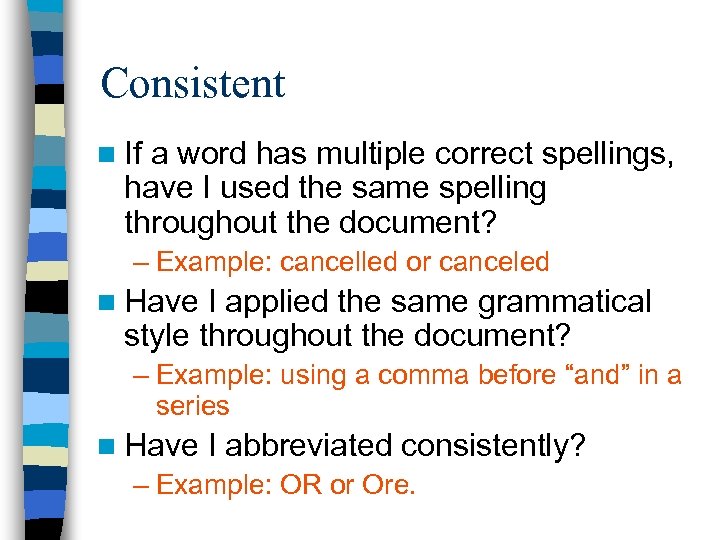
Consistent n If a word has multiple correct spellings, have I used the same spelling throughout the document? – Example: cancelled or canceled n Have I applied the same grammatical style throughout the document? – Example: using a comma before “and” in a series n Have I abbreviated consistently? – Example: OR or Ore.
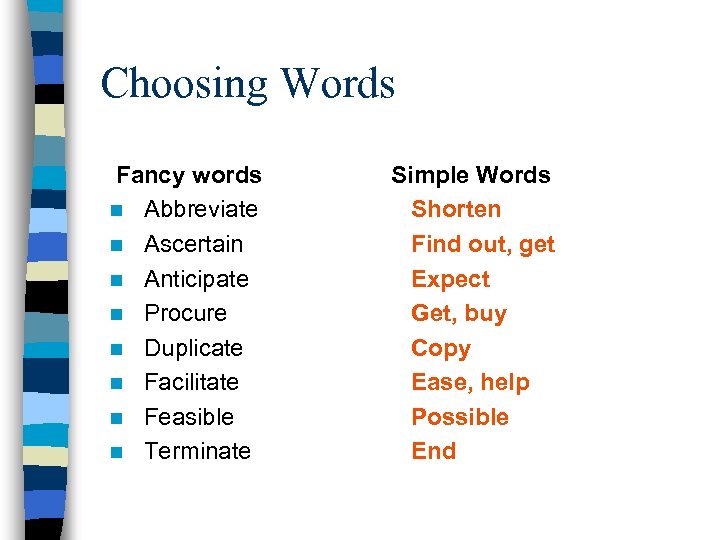
Choosing Words Fancy words n Abbreviate n Ascertain n Anticipate n Procure n Duplicate n Facilitate n Feasible n Terminate Simple Words Shorten Find out, get Expect Get, buy Copy Ease, help Possible End

Choosing Words Fancy Words n Optimum n Indicate n Attempt n Obtain n Commence n Demonstrate n Locate Simple Words Best Tell, say, show Try Get Begin Show Find
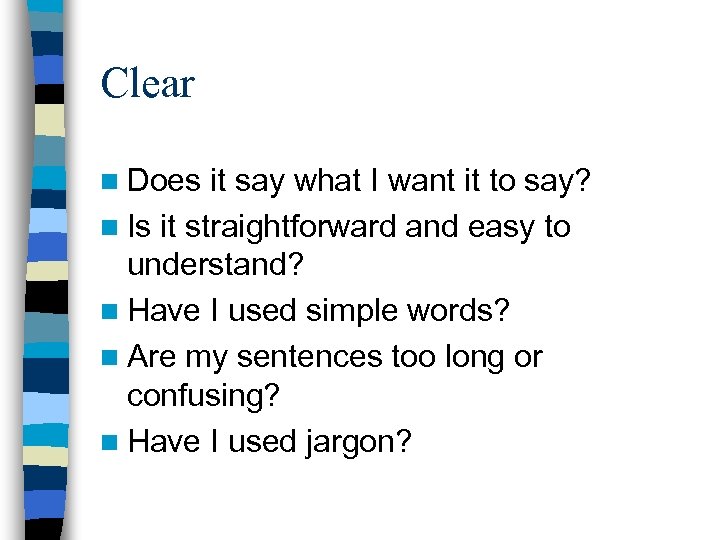
Clear n Does it say what I want it to say? n Is it straightforward and easy to understand? n Have I used simple words? n Are my sentences too long or confusing? n Have I used jargon?
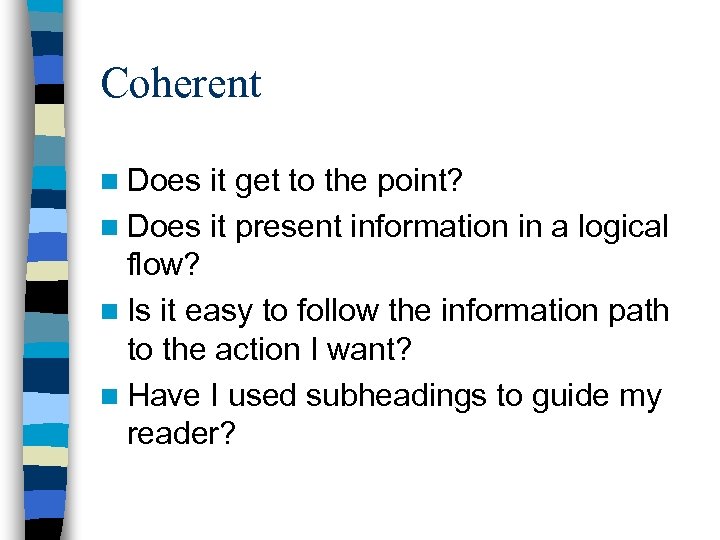
Coherent n Does it get to the point? n Does it present information in a logical flow? n Is it easy to follow the information path to the action I want? n Have I used subheadings to guide my reader?
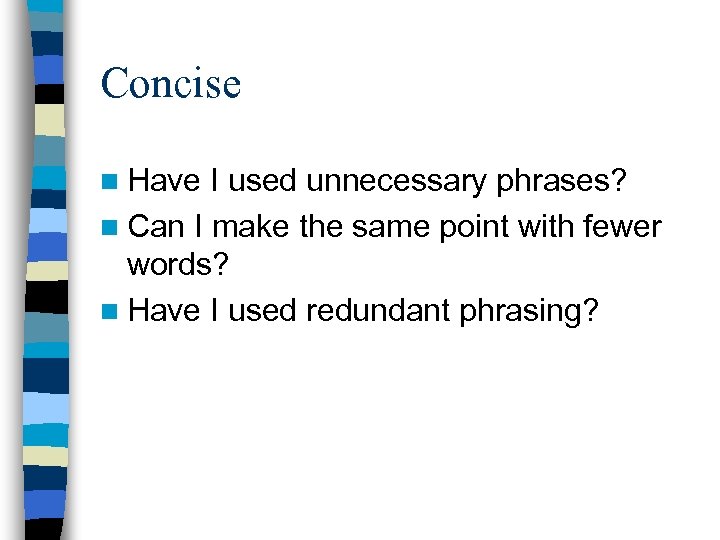
Concise n Have I used unnecessary phrases? n Can I make the same point with fewer words? n Have I used redundant phrasing?
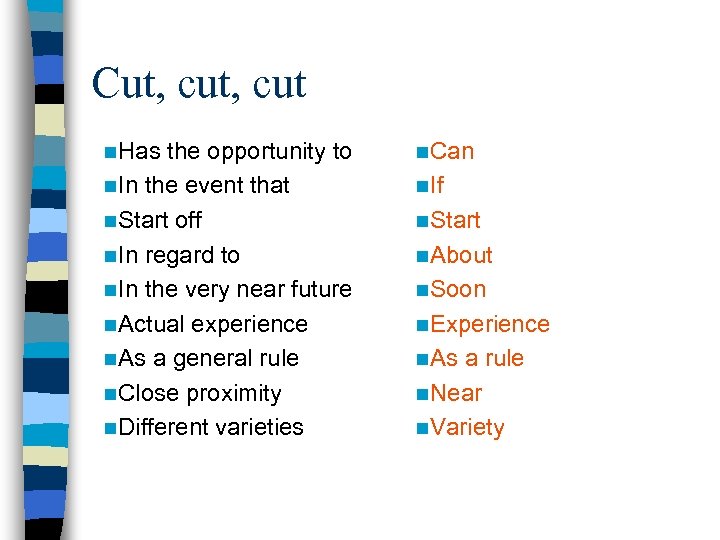
Cut, cut n. Has the opportunity to n. In the event that n. Start off n. In regard to n. In the very near future n. Actual experience n. As a general rule n. Close proximity n. Different varieties n. Can n. If n. Start n. About n. Soon n. Experience n. As a rule n. Near n. Variety
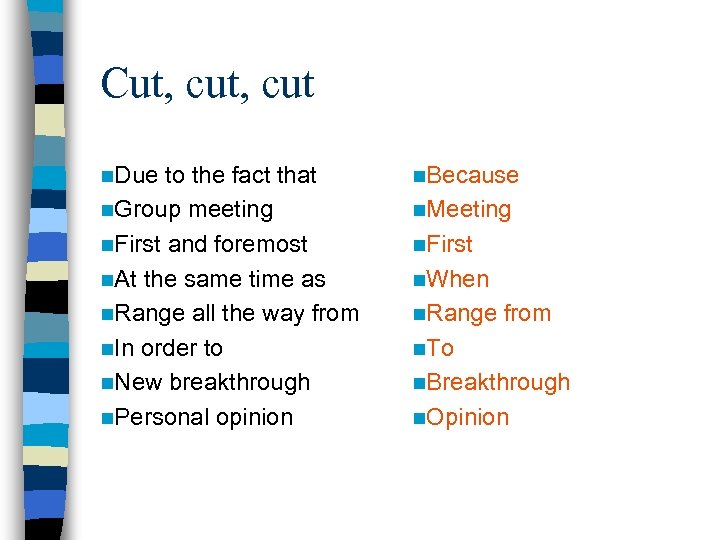
Cut, cut n. Due to the fact that n. Group meeting n. First and foremost n. At the same time as n. Range all the way from n. In order to n. New breakthrough n. Personal opinion n. Because n. Meeting n. First n. When n. Range from n. To n. Breakthrough n. Opinion

Complete n Have I included all the information that the reader will need? n Have I answered who, what, when, where, why, how much? n Have I answered the questions the reader is likely to have?
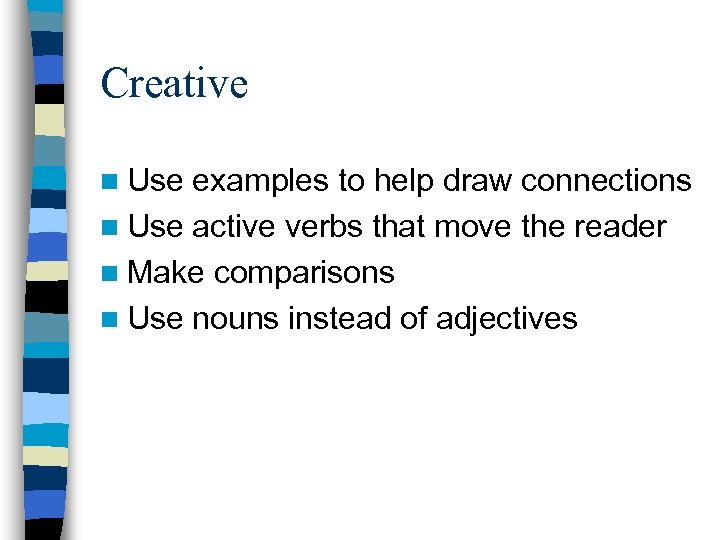
Creative n Use examples to help draw connections n Use active verbs that move the reader n Make comparisons n Use nouns instead of adjectives
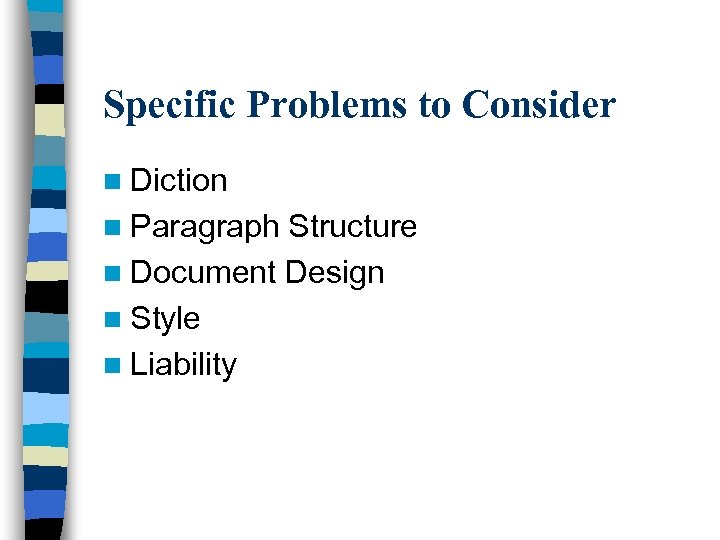
Specific Problems to Consider n Diction n Paragraph Structure n Document Design n Style n Liability
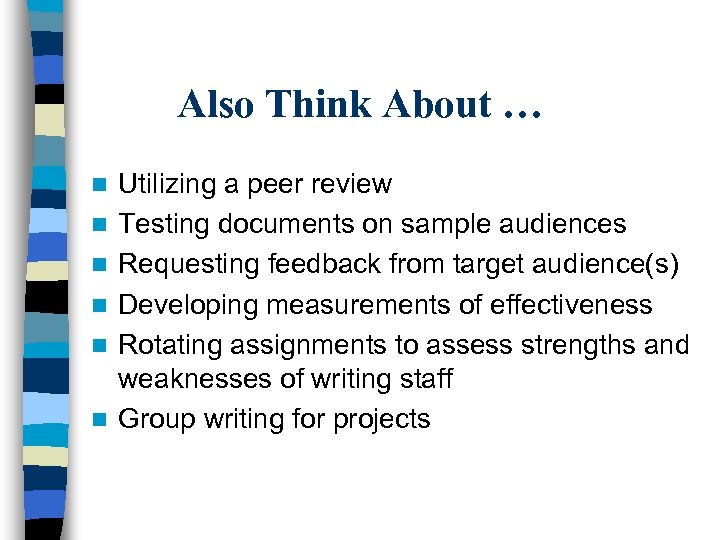
Also Think About … n n n Utilizing a peer review Testing documents on sample audiences Requesting feedback from target audience(s) Developing measurements of effectiveness Rotating assignments to assess strengths and weaknesses of writing staff Group writing for projects
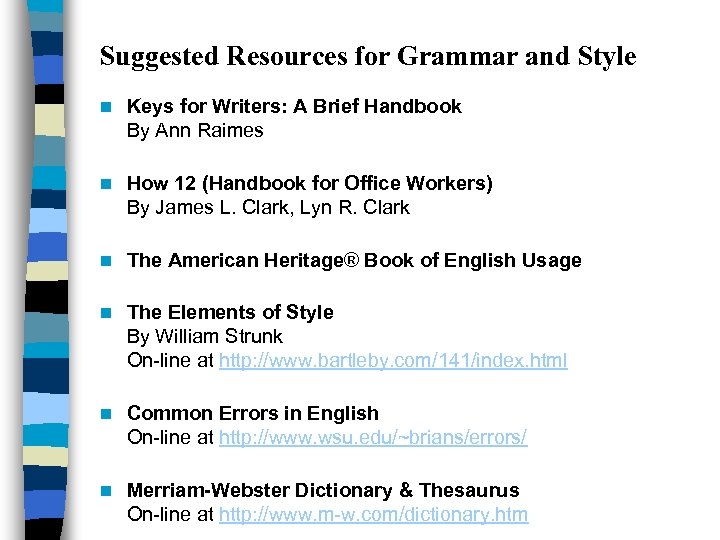
Suggested Resources for Grammar and Style n Keys for Writers: A Brief Handbook By Ann Raimes n How 12 (Handbook for Office Workers) By James L. Clark, Lyn R. Clark n The American Heritage® Book of English Usage n The Elements of Style By William Strunk On-line at http: //www. bartleby. com/141/index. html n Common Errors in English On-line at http: //www. wsu. edu/~brians/errors/ n Merriam-Webster Dictionary & Thesaurus On-line at http: //www. m-w. com/dictionary. htm
9b3231a3f2ecb4896d8dfba841947581.ppt